Home » Cellular Services (Page 7)
Category Archives: Cellular Services
The Poor Wise Man’s Burglar Alarm System with Asterisk: Under $10/month

If you’re like us, spending $50 a month or more on a home security system is a bit like pouring money down the toilet. Add to that the complications of getting one to work reliably with VoIP without spending another $50 a month on a Ma Bell vintage telephone line just adds insult to injury.
So perhaps you can share our elation when an email arrived last week announcing Straight Talk’s new Remote Alert System, a $10/month cellular-based system that uses Verizon Wireless to provide SMS and phone call alerts for up to eight numbers. And actually it’s cheaper than that. $100 buys you a year of service. That’s less than $8.50 a month. Today we’ll show you how to transform your Prius-like Remote Alert System into a Tesla that will rival virtually any intrusion detection system on the market… at any price! The extra hardware required: any Asterisk-based server including the Raspberry Pi and BeagleBone Black.
Read and weep, ADT!
If we didn’t already have three Straight Talk lines of service, we would have filed this in the Too Good To Be True pile and moved on. But we’ve had terrific Almost-Unlimited™ AT&T Wireless service with Straight Talk for less than $500 a year. It’s not only indistinguishable from AT&T’s own offerings costing at least 50% more, but it’s also contract-free so we can bring any AT&T smartphone including iPhones to the party and never miss a beat.
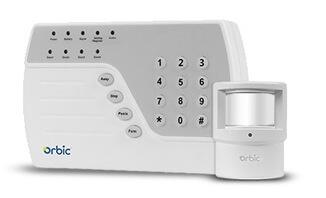
We decided to take the bait and ordered the home security bundle. This gets you the Remote Alert wireless controller plus a wireless motion sensor plus a year of service for $229.99. If you prefer a one-month gamble, the bundle is only $139.99. Down the road, you can add additional motion sensors and window/door sensors for about $30 each. The add-ons now are available at Wal-Mart.
Shameless Plug. We obviously don’t charge for access to our articles. But you can assist the Nerd Vittles project financially by using our referral link with eBates® to make your purchase if you decide to try this. It doesn’t cost you a dime but returns 13.5% of your purchase price to the Nerd Vittles project. It’s just a couple of clicks.  Start here to access eBates.
Start here to access eBates.  Then Search for Straight Talk and click on the link. After the Straight Talk web site displays, click on the following link to access the Straight Talk Security Bundle. And, THANK YOU!
Then Search for Straight Talk and click on the link. After the Straight Talk web site displays, click on the following link to access the Straight Talk Security Bundle. And, THANK YOU!
So… back to our story. The controller supports four zones for monitoring. Zone 4 is reserved for sensors you want to monitor while someone may still be moving around in the house, for example while only some of your family may be sleeping or if pets are roaming. The other three zones typically would be used for motion sensors that trigger alerts when anything moves… after giving you 30 seconds to leave and return, of course. You can activate Home or Away monitoring using either the controller, an optional $25 key fob, or a free app for your iPhone or Android smartphone.
You get to decide what happens when the system is armed and an alert is triggered either by motion or a monitored door or window being opened. For us, silence was the name of the game. Using the Android Remote Alert System, click the Silent ARM icon once you leave the house, and you’re done. When you return, click the Disarm icon within 30 seconds of opening the door, and monitoring is disabled. You can also enter your 4-digit alarm code on the controller to disable monitoring.
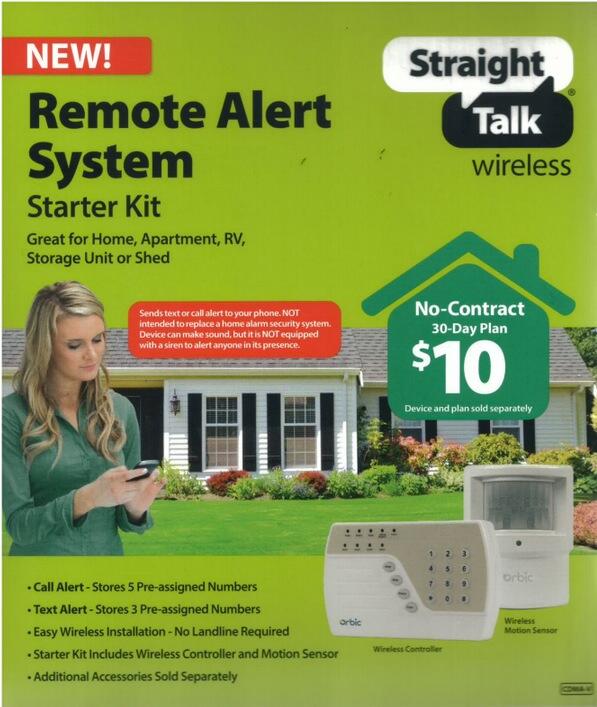
Remote Alert System Setup. Once you get the equipment, it’s a 5-minute phone call to get set up. Install the backup batteries in the controller and motion detector, and plug the controller into an A/C power source. Press the required sequence on the controller to activate it, and you’re in business. The motion detector is already paired with the controller when it arrives, but adding new sensors is a 15-second task. All of the commands are documented in the manual which accompanies the system. But the tutorials also are available on line if you want to have a look.
Step #1 is changing your security alarm password. The next step is entering your phone numbers. Straight Talk goes to great lengths warning you that this is not a home security system because it has no external siren and can’t make 911 calls. They obviously haven’t heard of Asterisk®. 🙂 But let’s get through the standard setup before we talk about Asterisk integration. You get to set up three numbers to receive SMS text messages when an alarm is triggered. And you get to set up five phone numbers to receive calls when an alarm is triggered. What the called party will actually hear is an obnoxious alarm tone which continues to play for 15 seconds. If you had multiple properties with alarm systems and no Caller ID, you’d never know the source of the alarm! But people with multiple properties probably aren’t smart enough to use this system to begin with so let’s move on. You configure the SMS and phone numbers by entering a special code on the controller to program each of the eight destinations. Then you enter the 10-digit number twice, and you’re done. Easy Peasy!
If you’re new to home security systems, the key to motion sensors is placement. Straight Talk recommends placement about seven to ten feet off the floor with a wide field of view. The range of the motion sensor is about 26 feet. It obviously depends upon the layout of your house or apartment, but we had much better success placing the motion sensor on a window sill at about 5 feet high and aiming it at the center hall of our home. It improved the motion detection dramatically. Trial and error is your friend!
The next step is positioning your controller. A mounting bracket is included so that you can place it almost anywhere you like. Our preference is to hide it so long as it still has Verizon cellular coverage and a source of electricity. You can test it by arming the controller with your smartphone and then triggering the motion sensor. If you get an SMS message or a call, it’s working. We also prefer silent mode. An intruder is obviously going to attempt to destroy your controller if they hear it. Yes, the intruder may leave, but they’ll probably carry some of the family jewels with them. With an Asterisk server in place, we’d prefer to send the police without alerting the intruder that something has gone wrong.
Asterisk Integration. Speaking of Asterisk, here’s what we’ve developed to add 911 alerts and telephone alarms to this system. It’s a 5-10 minute project! The way this works is to first add a phone number to your controller that calls a dedicated DID on your Asterisk server. Calls to that DID trigger the special context [st-remote-alert] which verifies the CallerID number of your alarm system. As configured, if the CallerID doesn’t match, the call is immediately disconnected although you could easily modify our code to use an existing (non-dedicated) DID if you prefer. Just route the non-matching CallerIDs to whatever context you traditionally use to process inbound calls. If the CallerID of the alarm system is matched, then the call is disconnected AND an outbound call is placed to 911. When the 911 operator answers, a prerecorded message is played at least twice that says something like this using REAL information:
This is an automated security request for assistance from the residence at 36 Elm Street in Podunck, Arkansas. The owner of this residence is Joe Schmo at phone number: 678-123-8888. An intruder has been detected inside the home. A suspected burglary is in progress. All of the residents of the home are unavailable to place this call. Please send the police.
The phone number from which this automated call is being placed is 678-123-4567. If the owners have a working cell phone, you can reach them at the following number: 678-123-9999. Please dispatch the police to 36 Elm Street immediately, whether you can reach the owners or not.
A suspected burglary is in progress. Thank you for your assistance. This message will repeat until you hang up…
You can either use Flite and Igor to play the message, or you can record your own message to be played to 911. Use the FreePBX® Admin -> System Recordings option. We recommend the latter especially since you’ll be sending these emergency calls to 911. You obviously want the 911 operator to be able to quickly decipher what’s being said.
Legal Disclaimer. We cannot stress strongly enough that you need to test this carefully on your own server by placing test calls to some number other than 911 until you are positive that it is working reliably as determined solely by you. Be advised that this system will not work at all in the event of an electrical, Internet, or server outage. As delivered, this code will NOT place calls to 911. The choice of whether to modify the code to place 911 emergency calls is solely yours to make. Be advised that false and inadvertent calls to 911 may result in civil and criminal penalties. DON’T BLAME US!
NO WARRANTIES, EXPRESS OR IMPLIED, INCLUDING THE IMPLIED WARRANTY OF FITNESS
FOR A PARTICULAR PURPOSE AND MERCHANTABILITY, ARE BEING PROVIDED.
BY PROCEEDING WITH IMPLEMENTATION AND INSTALLATION OF THIS SOFTWARE, YOU AGREE
TO ASSUME ALL RISK AND COMPLETE RESPONSIBILITY FOR ANY AND ALL CONSEQUENCES
OF IMPLEMENTATION WHETHER INTENDED OR NOT AND WHETHER IMPLEMENTED CORRECTLY
OR NOT. YOU ALSO AGREE TO HOLD WARD MUNDY, WARD MUNDY & ASSOCIATES LLC, AND
NERD VITTLES HARMLESS FROM ALL CLAIMS FOR ACTUAL OR CONSEQUENTIAL DAMAGES.
BEFORE IMPLEMENTING AUTOMATED 911 CALLS, CHECK WITH A LOCAL ATTORNEY TO MAKE
CERTAIN THAT SUCH CALLS ARE LEGAL IN YOUR JURISDICTION.
IN THE EVENT THAT ANY OF THESE TERMS AND CONDITIONS ARE RULED UNENFORCEABLE,
YOU AGREE TO ACCEPT $1.00 IN COMPENSATION FOR ANY AND ALL CLAIMS YOU MAY HAVE.
THIS SOFTWARE IS FREE AND YOU AGREE TO ASSUME ALL RISKS WHETHER INTENDED OR NOT.
YOU ALSO ACKNOWLEDGE AND UNDERSTAND THAT THINGS CAN GO WRONG IN TECHNOLOGY.
WE CANNOT AND DO NOT WARRANT THAT THIS CODE IS ERROR-FREE OR THAT IT WILL
PROTECT YOUR PROPERTY, YOUR LOVED ONES, OR ANYONE, OR ANY THING IN ANY WAY.
IF YOU DO NOT AGREE WITH THESE TERMS AND CONDITIONS OF USE, DO NOT PROCEED!
Asterisk Implementation. First, you’ll need a dedicated DID that can be used to receive incoming calls from your Remote Alert System. Hopefully, you won’t be receiving many calls on this number so any of the inexpensive pay-by-the-minute DIDs will suffice. Or you can use a free DID from ipkall.com. The only gotcha with ipkall.com is having to make a call to keep the number active at least once every 30 days. But this could be accomplished with a weekly telephone reminder that only connected for a few seconds. Just don’t make the weekly call using the CallerID of your alarm system. You obviously do not want to trigger a 911 emergency call.
Next, you’ll need an outbound trunk on your Asterisk server that’s previously been registered with E911 support and that already is configured to place outbound 911 calls from your server. Google Voice trunks will not work! Your name, address, and phone number as they were registered with E911 will be important pieces of information to relay in your automated emergency call to 911. You’ll also need a cellphone number that can be provided with your 911 calls so that emergency responders have a way to contact you to follow up on automated emergency calls from your server.
Temporarily, you’ll also need a 10-digit number to which to deliver the automated emergency calls for testing. Your cellphone number would suffice. Once you’re sure everything is working, we’ll show you how to modify the dial plan code to replace this number with 911 when your system goes "live."
Installation. Once you have all of the required pieces in place, you’re ready to begin the installation. Log into your server as root and issue the following commands to begin:
cd /root wget http://nerdvittles.com/wp-content/st-remote-alert.tar.gz tar zxvf st-remote-alert.tar.gz rm -f st-remote-alert.tar.gz ./st-remote-alert.sh
Once the install is finished, use FreePBX to modify the DID Trunk that will receive the incoming alerts from your Remote Alert System. Change the context entry to: context=st-remote-alert
Test. Test. Test. Testing is critically important before you actually turn on automated calls to 911. Once you’ve installed the software, activate your Remote Alarm System and then trip the motion detector to trigger a call to the dedicated DID on your Asterisk server. There’s typically a 30-second delay between tripping a motion detector and the commencement of the alert calls. Within a minute, you should receive a call on the emergency number you set up for testing. You can follow the progress of the procedure using the Asterisk CLI: asterisk -rvvvvvvvvvv. We recommend testing this repeatedly for at least a month before even considering 911 deployment. Make certain that everyone in your household knows how to disable the alarm system when they return home after arming it. Make certain that everyone in your household knows to never arm the system with motion detectors activated when anyone or any animal inside the house could potentially trip the alarm. At least until everyone is accustomed to these new security procedures and has a proven (successful) track record, NEVER DEPLOY SILENT ARMING OF YOUR REMOTE ALERT SYSTEM! If you change to silent arming of the Remote Alert System, test for at least another full month with no inadvertent failures before considering 911 deployment.
Making Changes. The st-remote-alert.sh installer has been designed to let you run it over and over again to replace or update your settings. So don’t be shy about making changes.
Substituting a Personally Recorded Message. If you’d prefer to record your own message to be delivered to 911, then review the script above and make yourself a cheat sheet before you begin. Then use a browser to open FreePBX. Choose Admin -> System Recordings and enter an extension number on your system to use for recording. Click the Go button to begin. Then dial *77 from that extension and record your message. Press # when you’re finished. Be sure to listen to the recording to make sure it’s what you intended. If not, rerecord the message until you get it right. You can dial *99 to listen to your recording a final time. When you’re sure it’s correct, name the recording nv-alert. Click Save.
Now you need to tell the automated alert dialer to use your recorded message instead of Flite and Igor.
Edit /etc/asterisk/extensions_custom.conf. Search for the line containing "pickrecording". Change Extension: 4 to Extension: 5. Save the file and reload your dial plan: asterisk -rx "dialplan reload"
Do some additional testing if you have substituted your own recording!
Adding Audible Alarms During Emergencies. If you prefer a little noise sprinkled around your home during burglaries, then we’ve put in place the necessary components to sound alarms on SIP phones that support AutoAnswer after feeding an extension to the speakerphone. For example, assuming you have deployed a Yealink T46G with an IP address of 192.168.0.10 and default admin credentials, you could add this additional line just before the final s,n,Hangup line in the [st-remote-alert] context of /etc/asterisk/extensions_custom.conf:
exten => s,n,System(curl -s -S --user-agent "Alert" http://admin:admin@192.168.0.10/servlet?number=25276)
To add additional Yealink phones, just add additional lines to the dialplan with the IP address of each phone. For other phone models, you’ll need to do a little research. 😉
Going Live with Automated Emergency Calls to 911. When you and everyone in your household are absolutely comfortable with the arming, disarming, and motion detection procedures, then you can decide whether to reroute the automated notifications to 911. Be advised that, in some states or municipalities, it may be illegal to auto-dial 911 from a non-human caller/system. Before doing this, check with an attorney or local authorities in your jurisdiction to make sure you are in compliance with federal/state/local laws.1 If you elect to proceed, edit extensions_custom.conf in /etc/asterisk. Search for the line containing "SEND-HELP-REQUEST-TO". Replace the temporary number that you set up with the number: 911. Save the file and reload your dial plan: asterisk -rx "dialplan reload". Sleep well!
Originally published: Monday, July 14, 2014
 Support Issues. With any application as sophisticated as this one, you’re bound to have questions. Blog comments are a terrible place to handle support issues although we welcome general comments about our articles and software. If you have particular support issues, we encourage you to get actively involved in the PBX in a Flash Forums. It’s the best Asterisk tech support site in the business, and it’s all free! Please have a look and post your support questions there. Unlike some forums, ours is extremely friendly and is supported by literally hundreds of Asterisk gurus and thousands of users just like you. You won’t have to wait long for an answer to your question.
Support Issues. With any application as sophisticated as this one, you’re bound to have questions. Blog comments are a terrible place to handle support issues although we welcome general comments about our articles and software. If you have particular support issues, we encourage you to get actively involved in the PBX in a Flash Forums. It’s the best Asterisk tech support site in the business, and it’s all free! Please have a look and post your support questions there. Unlike some forums, ours is extremely friendly and is supported by literally hundreds of Asterisk gurus and thousands of users just like you. You won’t have to wait long for an answer to your question.

Need help with Asterisk? Visit the PBX in a Flash Forum.
Special Thanks to Our Generous Sponsors
FULL DISCLOSURE: ClearlyIP, Skyetel, Vitelity, DigitalOcean, Vultr, VoIP.ms, 3CX, Sangoma, TelecomsXchange and VitalPBX have provided financial support to Nerd Vittles and our open source projects through advertising, referral revenue, and/or merchandise. As an Amazon Associate and Best Buy Affiliate, we also earn from qualifying purchases. We’ve chosen these providers not the other way around. Our decisions are based upon their corporate reputation and the quality of their offerings and pricing. Our recommendations regarding technology are reached without regard to financial compensation except in situations in which comparable products at comparable pricing are available from multiple sources. In this limited case, we support our sponsors because our sponsors support us.
 BOGO Bonaza: Enjoy state-of-the-art VoIP service with a $10 credit and half-price SIP service on up to $500 of Skyetel trunking with free number porting when you fund your Skyetel account. No limits on number of simultaneous calls. Quadruple data center redundancy. $25 monthly minimum spend required. Tutorial and sign up details are here.
BOGO Bonaza: Enjoy state-of-the-art VoIP service with a $10 credit and half-price SIP service on up to $500 of Skyetel trunking with free number porting when you fund your Skyetel account. No limits on number of simultaneous calls. Quadruple data center redundancy. $25 monthly minimum spend required. Tutorial and sign up details are here.
 The lynchpin of Incredible PBX 2020 and beyond is ClearlyIP components which bring management of FreePBX modules and SIP phone integration to a level never before available with any other Asterisk distribution. And now you can configure and reconfigure your new Incredible PBX phones from the convenience of the Incredible PBX GUI.
The lynchpin of Incredible PBX 2020 and beyond is ClearlyIP components which bring management of FreePBX modules and SIP phone integration to a level never before available with any other Asterisk distribution. And now you can configure and reconfigure your new Incredible PBX phones from the convenience of the Incredible PBX GUI.
 VitalPBX is perhaps the fastest-growing PBX offering based upon Asterisk with an installed presence in more than 100 countries worldwide. VitalPBX has generously provided a customized White Label version of Incredible PBX tailored for use with all Incredible PBX and VitalPBX custom applications. Follow this link for a free test drive!
VitalPBX is perhaps the fastest-growing PBX offering based upon Asterisk with an installed presence in more than 100 countries worldwide. VitalPBX has generously provided a customized White Label version of Incredible PBX tailored for use with all Incredible PBX and VitalPBX custom applications. Follow this link for a free test drive!
 Special Thanks to Vitelity. Vitelity is now Voyant Communications and has halted new registrations for the time being. Our special thanks to Vitelity for their unwavering financial support over many years and to the many Nerd Vittles readers who continue to enjoy the benefits of their service offerings. We will keep everyone posted on further developments.
Special Thanks to Vitelity. Vitelity is now Voyant Communications and has halted new registrations for the time being. Our special thanks to Vitelity for their unwavering financial support over many years and to the many Nerd Vittles readers who continue to enjoy the benefits of their service offerings. We will keep everyone posted on further developments.
Some Recent Nerd Vittles Articles of Interest…
- Autodialers that make emergency calls to E911 as part of a burglar alarm system are specifically exempted in some states such as Illinois. This comports with federal law under The Telephone Consumer Protection Act (47 U.S.C. § 227). Emergency robocalls are specifically exempted from the new PSAP Do-Not-Call Registry rules. See also this article about E911 laws in the Northeast. In most cases, but not all, these laws target abuse of the E911 system. Surprisingly, one town that reportedly prohibits ALL autodialing to 911 is Palo Alto, CA. And Paris, Tennessee also has joined the illegal club. Special thanks to @TheMole on the PIAF Forum for his excellent research. [↩]
FMC: The Future of Telephony with Vitelity’s vMobile and Asterisk in the Cloud
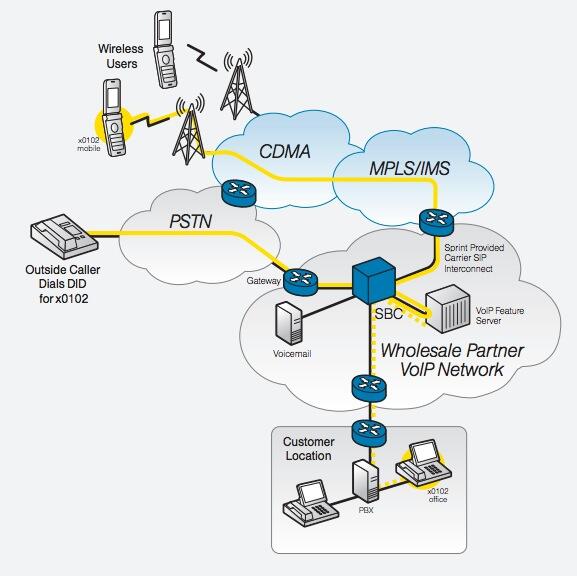
If making phone calls from a web browser is what you’ve always longed for, then you’re in good company with Google and its future direction in the telephony space. Call us old fashioned but this strikes us as a solution in desperate need of a problem. What’s wrong with a Plain Old Telephone or a smartphone for making connections with friends and business associates? The real head scratcher is the fact that the WebRTC and Hangouts push demonstrates that the wizards at Google are seriously out of touch with the next generation. Will our 14-year-old daughter use Skype or Hangouts or FaceTime? Sure. About once a month to chat with Grandma or to interact with cousins scattered around the country, it’s a terrific option. And the same is true in the business community. When you need to collaborate with a half dozen colleagues, conferencing applications are invaluable. But to meet 95% of day in and day out business requirements, a telephone or smartphone is the clear device of choice. So join us today in celebrating the end of Google Voice XMPP service and the beginning of a new and even more exciting VoIP era… sans Google.
Of course, if it were up to the next generation, telephone calls might completely disappear in favor of text messaging, Snapchat, Instagram, and any other platform that includes recorded photos or videos. Note the subtle difference. Kids really are not interested in live video interaction. They find posed images that tell a story much more appealing. Why? Because recorded photos and videos let users present their best face, their movie star pose, and their expression of what they want others to perceive they’re really like. In short, live video is too much like real life. Our conclusion for those targeting the next generation is you’d better come up with something better and quite different than Skype, Hangouts, and FaceTime.
It’s Fixed-Mobile Convergence, Stupid!
Now let’s return to our primary focus for today, the current business community. Suffice it to say, there are a dwindling number of what we used to call "desk jobs" where an employee arrives at his or her desk at 9 a.m. and leaves at 5 p.m. As more and more jobs are headed off shore, the telephone and smartphone have replaced the corporate desk as the most indispensable corporate fixture. Particularly in the American marketplace, what we see with most businesses is a management layer and an (upwardly) mobile force of salespeople, consultants, and implementers that interact primarily through PBXs in an office headquarters or home office together with smartphones for those that generally are on the road. Many of these Road Warriors don’t even have a home phone any longer.
The telephony Holy Grail for this new business model is Fixed-Mobile Convergence (FMC). It’s the ability to transparently move from place to place while retaining your corporate identity. Every employee from the night watchman in Miami to the salesperson making calls from a Starbucks in California to the CEO in New York has an extension on a PBX in the cloud together with the ability to accept and place calls using the company’s CallerID name and number, transfer calls, and participate in conference calls regardless of whether the phone instrument happens to be a desktop phone or a smartphone. Is this even possible? Well, as of last week, the answer is ABSOLUTELY.

Vitelity has been a long-time corporate sponsor of both the Nerd Vittles and PBX in a Flash open source projects so we were thrilled when we were offered a free, Samsung Galaxy S III to try out the new (live) vMobile service that took Best in Show honors at ITEXPO Miami in January. As Vitelity’s Chris Brown would probably tell you, it’s one thing to demonstrate a new technology at a trade show and quite another to bring it into production. But Vitelity did it:
What we want to stress up front is that we’ve received no special treatment in getting this to work. We received the phone, opened a support ticket to register the phone on Vitelity’s vMobile network, and plugged our new credentials into the phone so that it could be integrated into our PBX in a Flash server. Once the smartphone became an extension on our PBX, we could place calls through our PBX with the S3 using both WiFi and Sprint 3G/4G service. Switching between WiFi and cellular is totally transparent. The CallerID for all outbound calls was our standard PBX CallerID. We also could place calls to other extensions on the PBX by dialing a 4-digit extension while connected to WiFi or the Sprint network virtually anywhere. If you have 3-digit extensions, those are a problem over the Sprint network but we’ll show you a little trick to get them working as well.
Keep in mind that every call from the S3 goes out through the PBX just as if you were using a standard desktop phone as a hardwired extension. And it really doesn’t matter whether the S3 has a WiFi connection or a pure cellular connection on Sprint’s network. You receive calls on the S3 in much the same way. It’s just another extension on your PBX. If you want to add it to a ring group to process incoming calls, that works. If other users on your PBX wish to call the S3 directly using the extension number, that works as well. If you want to transfer a call, pressing ## on the S3 initiates the transfer just as if you were using a phone on your desk. When we say transparent convergence, we really do mean transparent. No recipient of a call from the vMobile S3 would have any idea whether you were sitting at a desk in the corporate headquarters in New York or in a seat on a Delta jet after landing in San Francisco. Both the call quality and the corporate CallerID would be identical. And your secretary on maternity leave at Grandma’s house still could reach you using her vMobile S3 by simply dialing your corporate extension.
So that’s the Fortune 500 view of the new VoIP universe. How about the little guy with a $15 a month PBX in a Flash server in the RentPBX cloud1, a couple mobile sales people, and a handful of construction workers that build swimming pools for a living? It works identically. Each has an S3 connected as an extension on the PIAF cloud server. And calls can be managed in exactly the same way they would be handled if everyone were sitting side-by-side at desks in an office headquarters somewhere. The silver lining of cloud computing is that it serves as the Great Equalizer between SOHO businesses and Fortune 500 companies. Asterisk® paired with inexpensive cloud hosting services such as RentPBX lets you mimic the Big Boys for pennies on the dollar. We think Vitelity has hit a bases loaded, home run with vMobile.
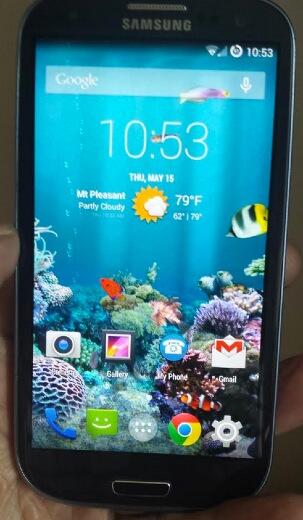
vMobile Pricing
We know what you’re thinking. "Since you got yours for free, what does it really cost??" The Galaxy S3 (or S4) is proprietary running Trebuchet 1.0, a (rooted) CyanogenMod version of Android’s KitKat. You can purchase these devices directly from the Vitelity Store. Currently, you can’t bring your own device. The refurbished S3 is $189 including warranty. Works perfectly! That’s what we’re using. Next, you’ll need a vMobile account for each phone. Unless you’re a Nerd Vittles reader, it’s $9.95 per month. That gets you free WiFi calling and data usage anywhere you can find an available WiFi hotspot. And text messaging is free. For calls and data using Sprint’s nationwide network, the calls are 2¢ a minute and the data is 2¢ per megabyte ($20 per gigabyte). For us, a typical day of data usage with an email account and light web use costs about a quarter. YMMV! So long as you configure Android to download application updates when connected to WiFi, data usage should not be a problem unless you’re into photos and streaming video. Android includes excellent tools for monitoring and even curbing your data usage if this is a concern.
vMobile Gotchas
Before we walk you through the setup process, let’s cover the gotchas. The list is short. First, we don’t recommend connecting vMobile devices to a PBX sitting behind a NAT-based firewall, or you may end up with some calls missing audio. The reason is NAT and quirky residential routers. If you think about it, when your S3 is inside the firewall and connected to WiFi, it will have an IP address on your private LAN just like your Asterisk server. When your S3 is outside your firewall on either a cellular connection or someone else’s WiFi network, it will have an IP address that is not on your private LAN. Others may be smarter than we are, but we couldn’t figure a way to have connections work reliably in both scenarios using most residential routers. You can configure your S3’s PBX extension for NAT=No or NAT=yes, but you can’t tell Asterisk how to change it depending upon where you are. One simple solution is to deploy these phones with a VPN connection to your Asterisk server sitting behind a NAT-based firewall. The more reliable solution is to build your PBX in a Flash server in the cloud with no NAT-based firewall. Then use an IPtables WhiteList (aka Travelin’ Man 3) to protect your server. From there, you can either interconnect the cloud-based server with a second PBX behind your firewall, or you can dispense with the local PBX entirely. Either way will eliminate the NAT issues with missing audio. In both cases, use NAT=yes for the vMobile extension.
Another wrinkle involves text messaging. Traditional text messages work fine; however, MMS still is problematic unless you initiate the outbound MMS session with the other recipient. It’s probably worth noting that Google Voice never got MMS working at all despite years of promises. This wasn’t a deal breaker for us, but it’s a bug that still is being worked on.
Finally, there’s Sprint. You either love ’em or hate ’em. We really haven’t used Sprint service in about eight years. In the Charleston area, the barely 3G service still is just as lousy as it was eight years ago. But, if you live in an area with good Sprint coverage and performance, this shouldn’t be an issue for you. And vMobile works fine in Charleston. You just won’t be surfing the web very often unless you have hours to kill… waiting. Additionally, dialing numbers with less than 4 numbers is a non-starter with Sprint, but we’ll show you a simple workaround to reach 3-digit local extensions from your vMobile device below.
With a service as revolutionary as vMobile with Sprint’s new FMC architecture, we can’t help thinking there may be other cellular carriers with an interest in deploying this technology sooner rather than later. But, given the vMobile feature set, Sprint is good enough for now especially when WiFi connectivity is available almost everywhere.
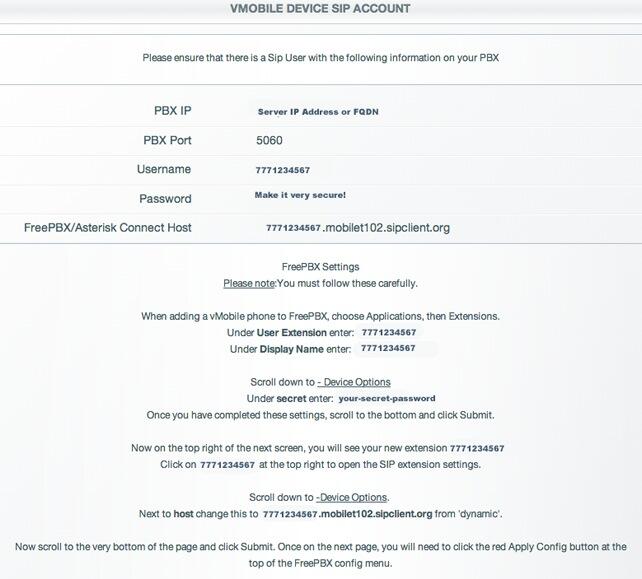
vMobile Configuration at Vitelity
For the Vitelity side of the setup, you first configure your smartphone using the (included) My Phone app. When the application is run, your cellphone number will be shown. Tapping the display about a dozen times will cause the phone’s setup to be reconfigured. Vitelity will provide you the secret key to activate your account. Next, you’ll log into the Vitelity portal and choose vMobile -> My Devices under My Products and Services. The account for your vMobile device will already exist. Clicking on the pull-down menu beside your vMobile device will let you create your SIP account on Vitelity’s server. Enter the IP address or FQDN of your Asterisk server and set up a very secure password. Your username will be the 10-digit phone number assigned to your vMobile phone. Save your settings and then choose the Edit option to view your setup. The portal will display your Username, Password, and FreePBX/Asterisk Connect Host name. Write them down for use when you configure your new extension using FreePBX®.
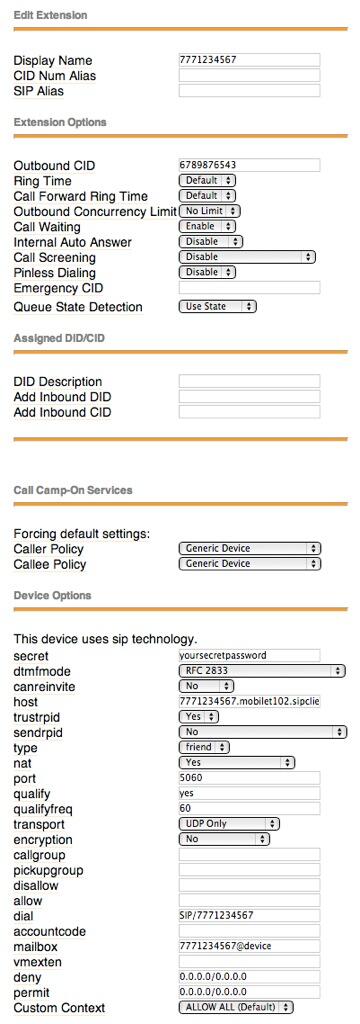
vMobile Configuration for Asterisk and PBX in a Flash
On the PBX in a Flash server, use a browser to open FreePBX. Choose Applications -> Extensions and add a new generic SIP device. For Display Name and User Extension, enter the 10-digit phone number assigned to your vMobile device. Under Secret, enter the password you assigned in Vitelity’s vMobile portal. Click Submit and reload FreePBX when prompted. Then edit the extension you just created. Set NAT=yes and change the Host entry from dynamic to the FQDN entry that was shown in Vitelity’s vMobile portal, e.g. 7209876542.mobilet103.sipclient.org. Update your configuration and restart FreePBX once again. Finally, from the Linux command prompt, restart Asterisk: amportal restart. If you’re using a WhiteList with IPtables such as Travelin’ Man 3, be sure to add a new WhiteList entry for your vMobile Host entry. Finally, add your vMobile extension to any desired Inbound Routes to make certain your vMobile device rings when desired.
You now should be able to place and receive calls on your vMobile device. If you want to be able to call 3-digit Asterisk extensions on both WiFi and while roaming on the Sprint cellular network, then you’ll need to add a little dialplan code since Sprint reserves 3-digit numbers for emergency services and will reject other calls with numbers of less than 4 digits. Here’s the simple fix. Always dial 3-digit extensions with a leading 0, e.g. 0701 to reach extension 701. We’ll strip off the leading zero before routing the call. The dialplan code below works whether you’re calling a local 3-digit extension or a 3-digit extension on an interconnected remote Asterisk server. Simply edit extensions_custom.conf in /etc/asterisk and insert the following code at the top of the [from-internal-custom] context. Then restart Asterisk: amportal restart. Note that we’ve set this up so that, if you have an extension 701 on both the local server and a remote server, the call will be connected to the local 701 extension. If you have different extension prefixes for different branch offices (e.g. 7XX in Atlanta and 8XX in Dallas), then this dialplan code will route the calls properly assuming you’ve configured an outbound route with the appropriate dial pattern for each branch office.
exten => _0XXX,1,Answer
exten => _0XXX,n,Wait(1)
exten => _0XXX,n,Set(NUM2CALL=${CALLERID(dnid):1})
exten => _0XXX,n,Dial(sip/${NUM2CALL})
exten => _0XXX,n,Dial(local/${NUM2CALL}@from-internal)
exten => _0XXX,n,Hangup
Vitelity vMobile Special for Nerd Vittles Readers
Now for the icing on the cake… We asked Vitelity if they would consider offering special pricing to Nerd Vittles readers and PBX in a Flash users. We’re pleased to report that Vitelity agreed. By using this special link when you sign up, the vMobile monthly fee will be $8.99 instead of $9.95. In addition, your first month is free with no activation fee. We told you last week that there was a very good reason for choosing Vitelity as your SIP provider. Now you know why.

And, if you’re new to Cloud Computing, take advantage of the RentPBX special for Nerd Vittles readers. $15 a month gets you your very own PBX in a Flash server in the Cloud. Just use this coupon code: PIAF2012. Enjoy!
Originally published: Thursday, May 15, 2014


Need help with Asterisk? Visit the PBX in a Flash Forum.
Special Thanks to Our Generous Sponsors
FULL DISCLOSURE: ClearlyIP, Skyetel, Vitelity, DigitalOcean, Vultr, VoIP.ms, 3CX, Sangoma, TelecomsXchange and VitalPBX have provided financial support to Nerd Vittles and our open source projects through advertising, referral revenue, and/or merchandise. As an Amazon Associate and Best Buy Affiliate, we also earn from qualifying purchases. We’ve chosen these providers not the other way around. Our decisions are based upon their corporate reputation and the quality of their offerings and pricing. Our recommendations regarding technology are reached without regard to financial compensation except in situations in which comparable products at comparable pricing are available from multiple sources. In this limited case, we support our sponsors because our sponsors support us.
 BOGO Bonaza: Enjoy state-of-the-art VoIP service with a $10 credit and half-price SIP service on up to $500 of Skyetel trunking with free number porting when you fund your Skyetel account. No limits on number of simultaneous calls. Quadruple data center redundancy. $25 monthly minimum spend required. Tutorial and sign up details are here.
BOGO Bonaza: Enjoy state-of-the-art VoIP service with a $10 credit and half-price SIP service on up to $500 of Skyetel trunking with free number porting when you fund your Skyetel account. No limits on number of simultaneous calls. Quadruple data center redundancy. $25 monthly minimum spend required. Tutorial and sign up details are here.
 The lynchpin of Incredible PBX 2020 and beyond is ClearlyIP components which bring management of FreePBX modules and SIP phone integration to a level never before available with any other Asterisk distribution. And now you can configure and reconfigure your new Incredible PBX phones from the convenience of the Incredible PBX GUI.
The lynchpin of Incredible PBX 2020 and beyond is ClearlyIP components which bring management of FreePBX modules and SIP phone integration to a level never before available with any other Asterisk distribution. And now you can configure and reconfigure your new Incredible PBX phones from the convenience of the Incredible PBX GUI.
 VitalPBX is perhaps the fastest-growing PBX offering based upon Asterisk with an installed presence in more than 100 countries worldwide. VitalPBX has generously provided a customized White Label version of Incredible PBX tailored for use with all Incredible PBX and VitalPBX custom applications. Follow this link for a free test drive!
VitalPBX is perhaps the fastest-growing PBX offering based upon Asterisk with an installed presence in more than 100 countries worldwide. VitalPBX has generously provided a customized White Label version of Incredible PBX tailored for use with all Incredible PBX and VitalPBX custom applications. Follow this link for a free test drive!
 Special Thanks to Vitelity. Vitelity is now Voyant Communications and has halted new registrations for the time being. Our special thanks to Vitelity for their unwavering financial support over many years and to the many Nerd Vittles readers who continue to enjoy the benefits of their service offerings. We will keep everyone posted on further developments.
Special Thanks to Vitelity. Vitelity is now Voyant Communications and has halted new registrations for the time being. Our special thanks to Vitelity for their unwavering financial support over many years and to the many Nerd Vittles readers who continue to enjoy the benefits of their service offerings. We will keep everyone posted on further developments.
Some Recent Nerd Vittles Articles of Interest…
- RentPBX also is a corporate sponsor of the Nerd Vittles and PBX in a Flash projects. [↩]
Beware the Ides of May: It’s Hammertime for Google Voice
https://www.youtube.com/watch?v=NyEE0qpfeig
You don’t have to be a soothsayer to appreciate what’s about to happen in the VoIP community. In just two weeks, millions of telephones in the United States are about to go silent. Let’s begin with what we know and don’t know about Google Voice and Google’s May 15 deadline. Google has made it crystal clear that XMPP connectivity to Google Voice is going away on May 15. What that means is that inbound and outbound calling using an XMPP connection to Google Voice will no longer work, period. And the platform really doesn’t matter. That includes Asterisk, FreePBX, FreeSwitch, Yate, and GrooVe IP as well as hardware ATAs such has ObiHai devices. Why? The short answer is because Google says so, and they are/were paying the bills. The longer answer is that companies such as Microsoft and Apple that have proprietary communications platforms were not reciprocating with free connectivity to their services in the same way that Google was providing XMPP service. Another probable reason is that Google was taking a financial bath on Google Voice services which were being abused by many commercial organizations. Reportedly, as many as three to five million DIDs have been handed out as part of the Google Voice project with very little return on investment.
Some have suggested this is just another tempest in a teapot like Y2K. After all, Y2K came and went without many catastrophes. The difference is that businesses spent hundreds of millions of dollars preparing for Y2K to make certain there were no train wrecks. With Google Voice, many individuals have taken the ostrich approach with their heads buried in the sand pretending things are just going to work out. Without some effort on the part of those still using Google Voice, May 15 will be their Julius Caesar moment.
What to Do? One school of thought is that the "old fashioned" Google Voice connections using Python which simulated a web call with Google Chat will still function. If receiving and placing calls using your existing Google Voice numbers matters to you, take the opinions of these self-proclaimed experts with a grain of salt. Here’s what you need to appreciate. First, nobody outside of Google actually knows whether the Python approach will continue to function or not. Second, even if it works on May 15, nothing would preclude Google from making "adjustments" at any time that would disable this functionality. They’ve done it before. They can do it again. And Google has made it abundantly clear that they’re putting an end to the free gravy train. Third, it doesn’t take a rocket scientist to deduce that PSTN call forwarding using Google Voice may be the next axe to fall. This probably won’t happen on May 15, but who knows. Finally, should you decide to go down this road, be aware that it is a major coding project regardless of your platform. But, if this is the road you wish to travel, you can find some tips on making the transition here. You’ve been warned.
The Smarter Approach. Our recommendations today are limited to those in the United States. Our apologies, but that’s two-thirds of our readership and roughly 95% of those that currently rely upon Google Voice. The same recommendations apply to those in Europe and South America and the Far East if calls to destinations in the U.S. are a major part of your VoIP traffic. What do we recommend? First, become VoIP savvy! The provider you use for outbound calls need not be the provider you use for incoming calls. Not putting all your eggs in one basket is a very good idea in the VoIP world.
Call us Chicken Little if you must, but Outbound Calling with Google Voice is going away on May 15. So, in the next two weeks, you definitely need to come up with an alternative for call terminations in the U.S./Canada market. We think you have two options: purchase an all-you-can-eat plan that includes sufficient outbound calling minutes to meet your existing requirements. Or you can select a provider that offers pay by the minute service for all of your outbound calls. One advantage with most of the pay-by-the-minute providers is that you can set your CallerID as desired. Don’t be misled by the all-you-can-eat claims. Every VoIP provider imposes some sort of cap on outbound calling even if their plan is advertised as "unlimited." If your outbound calling minutes exceed 2000-3000 minutes a month, you’re going to be looking for a new provider within weeks because every provider that we know will drop you like a hot potato when you are no longer profitable in their business model. The other gotcha is that most, if not all, of the all-you-can-eat plans are restricted to residential (non-business) use.
Full Disclosure: We have a favorite all-you-can-eat provider (Vestalink) and a favorite pay-as-you-go provider (Vitelity), and both of them provide some financial support to the Nerd Vittles and PBX in a Flash projects; however, both were our favorites before they provided any support to our projects.
All-You-Can-Eat Calling Plans. We continue to like Vestalink (formerly Obivoice) even though their prices have increased since the release of our original article. That’s actually a good thing. There was no way they could have stayed in business with their original pricing model. On a new 2-year plan with unlimited U.S./Canada inbound AND outbound calls, E911 service, and a free DID in your choice of area codes, the current rate for 24 months is $89.99 which works out to roughly $3.50 a month. The service comes with a 30-day money-back guarantee.
Another option which we previously have covered is a hardware device such as the netTALK Duo. With an upfront $100 hardware investment, you get the same features as Vestalink for $30 a year which works out to less than 10¢ a day. With both services, you have the option of porting your existing Google Voice number for a one-time fee. With Vestalink, you also have the option of spoofing your outbound CallerID number with your existing Google Voice number once it is verified as belonging to you. We prefer the latter approach at least until Google gives some hint that their call forwarding of incoming Google Voice calls is going away. Both services are bargains in our view. But, as we noted, for residential service we still prefer the pure VoIP solution provided by Vestalink.
Pay-As-You-Go Call Terminations. Most of the reputable pay-by-the-minute providers charge between 1¢ and 2¢ a minute for outbound calls with charges billed in 6 to 10-second increments. Unless you make an enormous number of lengthy calls, these rates are a bargain. Vitelity remains our favorite provider primarily because of the flexibility their service offers in setting up multiple sub-accounts for use with Asterisk or FreeSwitch. A sign-up link with a 50% discount on most DIDs is provided here and at the end of this article. We appreciate your support of our VoIP projects!!

While it is not yet officially available, the most compelling reason to switch to Vitelity is vMobile, a new $9.99/month cellphone plan that will integrate your Vitelity cellphone (actually a Samsung Galaxy S III) directly into your Asterisk setup. What that means is calls to extensions on your Asterisk server will also ring on your cellphone. And your cellphone functions exactly like any other extension on your Asterisk server whether you’re operating on 3G, 4G, or LTE networks as well as on WiFi at your home or office. You’ll be able to park calls, transfer calls, set up call monitoring, conferencing, and recording just as if you were on a standard VoIP phone in your home or office. And you can’t beat the price. Inbound and outbound calls on WiFi are totally free. Calls received or placed over what appears to be Sprint’s nationwide network are 2¢ a minute, about the same cost as pure VoIP calls.
For pay-by-the-minute terminations, we always recommend you set up accounts with multiple providers. Then, by setting multiple trunk sequences in your outbound routes, you’ll always have successful calls even when a particular provider happens to have an outage. Other than perhaps a small deposit, redundancy costs you nothing since you only pay for calls that you actually place through each provider. For a current list of our favorite termination providers in both the U.S. and Canada, see this thread on the PIAF Forum.
Handling Incoming VoIP Calls. Here’s the bottom line. The one thing you don’t want to do is risk losing your phone number because of the Google Voice train wreck. We have noticed a dramatic difference in call reliability for incoming calls over the past few months. Perhaps it’s an upstream provider problem… and perhaps not. Whatever the reason, get your phone numbers ported out of Google Voice as quickly as you can. It doesn’t have to be in the next two weeks, but you are well advised to begin the porting process soon. The Nerd Vittles Vitelity link will get you a monthly rate of $3.95 for a Tier A DID with unlimited incoming calls each month and automatic server failover. There are a few less expensive DID providers but, when it comes to our phone number, we’ve always wanted a provider with rock-solid reliability, flexibility, and a proven track record. Vitelity meets those requirements in spades. As we noted at the outset, the other advantage in separating out your inbound and outbound trunks is that, when service gets disrupted (and it happens to the best of providers), you’re not completely dead in the water.
For the short term, so long as you have an existing DID in the U.S. or Canada, you can forward your incoming Google Voice calls to that DID by simply adding it as a call forwarding destination in your Google Voice profile. We also recommend adding your cellphone as an additional call forwarding destination. Finally, be sure to disable the Google Chat option in your Google Voice setup and remove the Google Voice trunk in your FreePBX Google Voice/Motif setup. Good luck!
Originally published: Thursday, May 1, 2014

Need help with Asterisk? Visit the PBX in a Flash Forum.
Special Thanks to Our Generous Sponsors
FULL DISCLOSURE: ClearlyIP, Skyetel, Vitelity, DigitalOcean, Vultr, VoIP.ms, 3CX, Sangoma, TelecomsXchange and VitalPBX have provided financial support to Nerd Vittles and our open source projects through advertising, referral revenue, and/or merchandise. As an Amazon Associate and Best Buy Affiliate, we also earn from qualifying purchases. We’ve chosen these providers not the other way around. Our decisions are based upon their corporate reputation and the quality of their offerings and pricing. Our recommendations regarding technology are reached without regard to financial compensation except in situations in which comparable products at comparable pricing are available from multiple sources. In this limited case, we support our sponsors because our sponsors support us.
 BOGO Bonaza: Enjoy state-of-the-art VoIP service with a $10 credit and half-price SIP service on up to $500 of Skyetel trunking with free number porting when you fund your Skyetel account. No limits on number of simultaneous calls. Quadruple data center redundancy. $25 monthly minimum spend required. Tutorial and sign up details are here.
BOGO Bonaza: Enjoy state-of-the-art VoIP service with a $10 credit and half-price SIP service on up to $500 of Skyetel trunking with free number porting when you fund your Skyetel account. No limits on number of simultaneous calls. Quadruple data center redundancy. $25 monthly minimum spend required. Tutorial and sign up details are here.
 The lynchpin of Incredible PBX 2020 and beyond is ClearlyIP components which bring management of FreePBX modules and SIP phone integration to a level never before available with any other Asterisk distribution. And now you can configure and reconfigure your new Incredible PBX phones from the convenience of the Incredible PBX GUI.
The lynchpin of Incredible PBX 2020 and beyond is ClearlyIP components which bring management of FreePBX modules and SIP phone integration to a level never before available with any other Asterisk distribution. And now you can configure and reconfigure your new Incredible PBX phones from the convenience of the Incredible PBX GUI.
 VitalPBX is perhaps the fastest-growing PBX offering based upon Asterisk with an installed presence in more than 100 countries worldwide. VitalPBX has generously provided a customized White Label version of Incredible PBX tailored for use with all Incredible PBX and VitalPBX custom applications. Follow this link for a free test drive!
VitalPBX is perhaps the fastest-growing PBX offering based upon Asterisk with an installed presence in more than 100 countries worldwide. VitalPBX has generously provided a customized White Label version of Incredible PBX tailored for use with all Incredible PBX and VitalPBX custom applications. Follow this link for a free test drive!
 Special Thanks to Vitelity. Vitelity is now Voyant Communications and has halted new registrations for the time being. Our special thanks to Vitelity for their unwavering financial support over many years and to the many Nerd Vittles readers who continue to enjoy the benefits of their service offerings. We will keep everyone posted on further developments.
Special Thanks to Vitelity. Vitelity is now Voyant Communications and has halted new registrations for the time being. Our special thanks to Vitelity for their unwavering financial support over many years and to the many Nerd Vittles readers who continue to enjoy the benefits of their service offerings. We will keep everyone posted on further developments.
Some Recent Nerd Vittles Articles of Interest…
The New VoIP Frontier: Meet the iPad Mini with Retina Display

Last week was interesting if for no other reason because Apple released an amazing new product without tooting a single trumpet. In fact, the iPad Mini with Retina display was quietly made available on Apple’s web site in the middle of the night. Most believe that the rationale was that the devices were in such short supply that Apple couldn’t afford the PR nightmare of releasing a new product that very few could buy. Guess what? It’s still available. You have to order on the web. Then you can either pick up the device at your local Apple Store, or have it shipped directly to you… from China. We ordered on Tuesday and received the unit on Friday. What struck us about the new iPad Mini is the striking resemblance to the old iPad Mini. One suspects that Apple is running out of magic bunnies to pull from the hat so we’re getting down to one new gee whiz feature per year. In fairness, the new iPad Mini not only has a Retina display, but also has the new A7 chip with 64-bit architecture. The CPU is up to four times faster while graphics performance saw an 800% improvement without sacrificing battery life. To be completely honest, Apple needed the extra horsepower to drive the retina display, and the battery life has been preserved by increasing its size considerably. Almost half of the inside of an iPad Mini is now nothing but battery. Hop over to iFixIt for all the details.
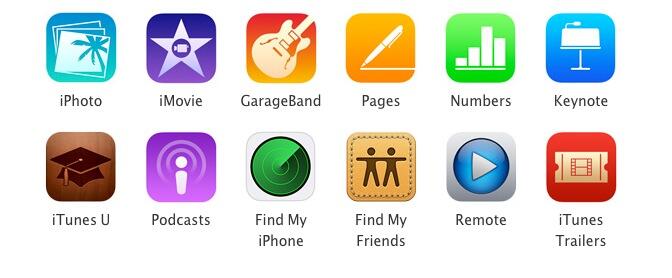
If the new hardware were the only addition, we probably would have had little interest in the new iPad Mini. But we learned a couple of years ago that there’s a dramatic difference in reading on a 7 inch tablet vs. an 8 inch tablet. And, when you add the retina display with 2048-by-1536 resolution and a staggering 326 pixels per inch, the iPad Mini becomes an almost perfect traveling companion for those that do a lot of reading. Apple also bundles an impressive list of business and productivity applications including Siri at no additional cost. For those that work on the Mac platform, the most important enhancement to these apps is that what you see on the Mac desktop using Pages, Numbers, or Keynote is exactly what you’ll see when the document is moved to either the iPad Air or iPad Mini with Retina display. For traveling business folks, that’s a huge improvement!

There have been some equally impressive additions on the communications front for those that enjoy Voice over IP technology. If you’re using PBX in a Flash™ or Asterisk®, we’re pleased to report that the Zoiper IAX client for iOS 7 works flawlessly. Simply set up an IAX extension on your server and enter your credentials in the Zoiper client on your iPad. Screwy as it sounds, Google has released Hangouts on the iOS 7 platform (only) with the added capability to place and receive PSTN phone calls anywhere in the world using a Google Voice PSTN phone number. And calls within the U.S. and Canada are free! Will it disappear? Will Google ever support it on their own Android devices? Who knows? We’ve given up trying to predict what Google will do next, but this addition will probably remain so long as Hangouts continues to be a viable platform. And Google seems to be staking their VoIP fortunes on Hangouts just as Apple has done with FaceTime and Microsoft with Skype. Of course, PSTN calls aren’t possible with FaceTime and, with Skype, PSTN calls are never free. So there is that important difference, and Hangouts fills that niche.
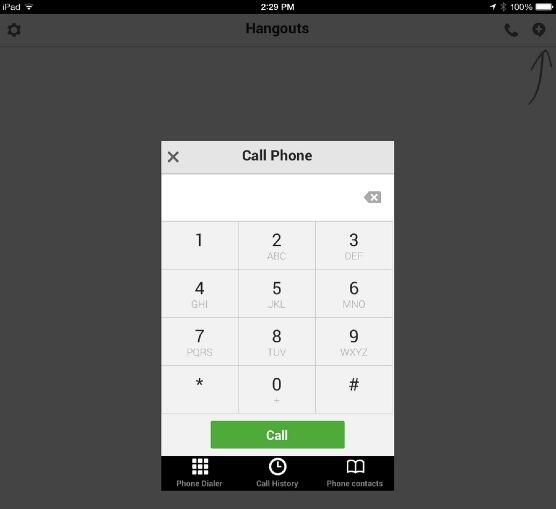
The other major software news is that Google Play Music now is available for iOS 7 as well. In addition to unlimited streaming of almost any music on the planet for $9.95 a month (to a single device at a time), you also can move 20,000 of your favorite songs to the Google Cloud and stream them for free. Apple offers free music alternatives as well including iTunes Radio which now is rolled into the iPad Music app.
There used to be a big reason for buying the cellular addition to the iPads. It made the GPS functionality work. Our Wi-Fi only unit had no problem pinpointing our location with nothing but a WiFi signal. Of course, if you have one of the new Verizon or AT&T bundled data plans, adding an iPad is just $10 a month. That alone would warrant purchase of the unlocked cellular model which now works with all cellular carriers. What a concept!
As you might expect, there are no deals to be had on the iPad Mini with Retina display. But, if you’re looking to buy a new iPad for Christmas, you should probably pay a visit to WalMart or Target on Black Friday. Both retailers are throwing in a $100 gift card with your purchase of the new iPad Air. Nobody other than Apple is yet selling the iPad Mini with Retina display. For another great review, see today’s coverage on The Verge. Enjoy!
Just Released: AstriCon 2013 Videos. Digium has just released all of the videos from AstriCon 2013 on the new YouTube Asterisk Channel.
Originally published: Monday, November 18, 2013

Need help with Asterisk? Visit the PBX in a Flash Forum.
Special Thanks to Our Generous Sponsors
FULL DISCLOSURE: ClearlyIP, Skyetel, Vitelity, DigitalOcean, Vultr, VoIP.ms, 3CX, Sangoma, TelecomsXchange and VitalPBX have provided financial support to Nerd Vittles and our open source projects through advertising, referral revenue, and/or merchandise. As an Amazon Associate and Best Buy Affiliate, we also earn from qualifying purchases. We’ve chosen these providers not the other way around. Our decisions are based upon their corporate reputation and the quality of their offerings and pricing. Our recommendations regarding technology are reached without regard to financial compensation except in situations in which comparable products at comparable pricing are available from multiple sources. In this limited case, we support our sponsors because our sponsors support us.
 BOGO Bonaza: Enjoy state-of-the-art VoIP service with a $10 credit and half-price SIP service on up to $500 of Skyetel trunking with free number porting when you fund your Skyetel account. No limits on number of simultaneous calls. Quadruple data center redundancy. $25 monthly minimum spend required. Tutorial and sign up details are here.
BOGO Bonaza: Enjoy state-of-the-art VoIP service with a $10 credit and half-price SIP service on up to $500 of Skyetel trunking with free number porting when you fund your Skyetel account. No limits on number of simultaneous calls. Quadruple data center redundancy. $25 monthly minimum spend required. Tutorial and sign up details are here.
 The lynchpin of Incredible PBX 2020 and beyond is ClearlyIP components which bring management of FreePBX modules and SIP phone integration to a level never before available with any other Asterisk distribution. And now you can configure and reconfigure your new Incredible PBX phones from the convenience of the Incredible PBX GUI.
The lynchpin of Incredible PBX 2020 and beyond is ClearlyIP components which bring management of FreePBX modules and SIP phone integration to a level never before available with any other Asterisk distribution. And now you can configure and reconfigure your new Incredible PBX phones from the convenience of the Incredible PBX GUI.
 VitalPBX is perhaps the fastest-growing PBX offering based upon Asterisk with an installed presence in more than 100 countries worldwide. VitalPBX has generously provided a customized White Label version of Incredible PBX tailored for use with all Incredible PBX and VitalPBX custom applications. Follow this link for a free test drive!
VitalPBX is perhaps the fastest-growing PBX offering based upon Asterisk with an installed presence in more than 100 countries worldwide. VitalPBX has generously provided a customized White Label version of Incredible PBX tailored for use with all Incredible PBX and VitalPBX custom applications. Follow this link for a free test drive!
 Special Thanks to Vitelity. Vitelity is now Voyant Communications and has halted new registrations for the time being. Our special thanks to Vitelity for their unwavering financial support over many years and to the many Nerd Vittles readers who continue to enjoy the benefits of their service offerings. We will keep everyone posted on further developments.
Special Thanks to Vitelity. Vitelity is now Voyant Communications and has halted new registrations for the time being. Our special thanks to Vitelity for their unwavering financial support over many years and to the many Nerd Vittles readers who continue to enjoy the benefits of their service offerings. We will keep everyone posted on further developments.
Some Recent Nerd Vittles Articles of Interest…
Meet the Goophone: It Walks Like a Duck and Quacks Like a Duck For Under $100
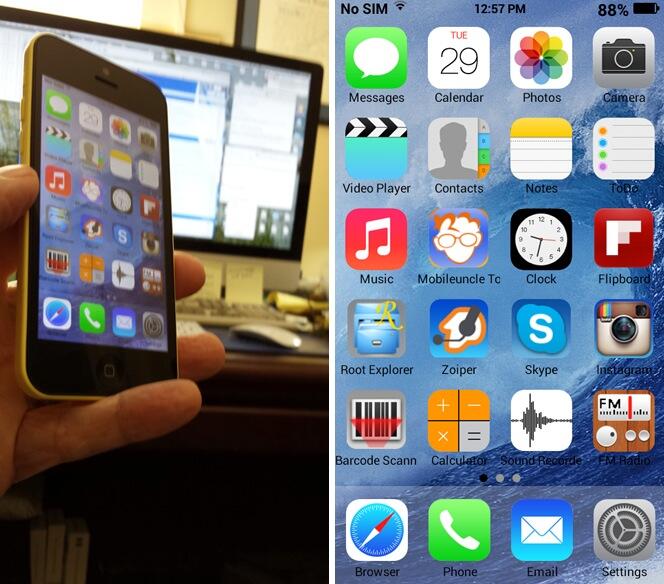
If you didn’t cheat and hover over the images above, then you’d be wrong if you guessed that you now can buy Apple’s shiny, new iPhone® 5c for less than $100. From first-hand experience, I can tell you that the price of the 32GB model without a contract remains $649. You can add another $50 for tax in most states. And you can add another $99 for AppleCare® and another $79 each time your daughter drops the phone on the pavement. No, my friends, this is not an iPhone 5c. It’s the Goophone i5c from DHgate.com and many others brought to you by some enterprising neighbors of the fine folks that manufacture phones for Apple® and Samsung® (among others) in China. As the back of the phone says: "Designed by Goophone in California. Assembled in China." Sound familiar? Not sure Goophone spent much time in California, but the phones are most definitely "assembled" in China. Total delivered price from DHgate: $89.99. While we had little clue about the similarities when we ordered the phone, with the exception of the Goophone logo emblazoned on the back of the phone and the prominent Goophone boot logo, you’d be hard-pressed to distinguish one duck from the other. My daughter’s iPhone 5c happens to be pink. So that helped with telling them apart.
What’s wrong with this picture? Well, lots. Let’s see. The potential patent, trademark, and copyright issues look like something a sadistic law professor might cook up for a bar exam. However, neither the International Trade Commission nor any American court has (yet) blocked the import of these phones so technically the manufacturer is entitled to the same presumptions as any other merchant. And proliferation of these phones in the United States is the least of Apple’s problems. Remember, Apple has been counting on the huge Chinese market as the Second Coming for iPhone sales. Considering the i5c was available before the iPhone 5c ever shipped, it seems fairly likely that there also may be a technology leak somewhere in someone’s pipeline. Let’s guess where that might be. What should be equally troubling to Apple is that someone could look at your $700 phone and build a perfectly functioning replica for under $40. Did we mention the build quality? It’s similar. Let’s leave it at that. In short, the Goophone knock off appears to be much what Apple claimed in court that Samsung was doing. It just didn’t happen to turn out that way in some of the Samsung litigation. But, as the old saying goes, be careful what you wish for. It turns out that the Goophone may actually be a better mousetrap than the iPhone especially when it comes to overall performance and battery life.
http://www.youtube.com/watch?v=F73sMmb6CS0
We’re not going to get into the morality or legality of buying stuff like this especially with Festivus just around the corner. So sort that out for yourself. Start with this New York Times article and then do some reading on the Freakonomics web site if you’re really curious. Suffice it to say there’s a major difference between a counterfeit and a knockoff. Counterfeit goods are those with someone else’s brand name splattered across the item. Think pocketbooks hidden in the blankets on the street corners around Times Square in New York. Most of these phones are clearly labeled with their own unique brand names. Examining the devices up close or after turning them on would explicitly tell any buyer that Goophones aren’t made or designed by Apple. All of the hardware and most of the software on the inside of the phone is different as well. So we believe the phones rise to the level of a knockoff which keeps buyers out of hot water. Keep in mind we’re talking about buying a phone, not selling one. Don’t even think about reselling them!
To borrow an expression from NASA: "Cupertino. We’ve got a problem." Before you get too mad at the Chinese, keep in mind that there’s plenty of blame to go around. Apple, for one, chose to make their phones in China to save money. While we were writing this article, Google® ads were popping up all over the place for these phones. And, of course, AT&T® and T-Mobile® are perfectly willing to sell you a nano SIM to use in your Goophone even though they could easily block the devices. The parcel delivery companies are more than happy to bring these phones into the U.S. by the boatload. And finally there’s this little tidbit in the New York Times article referenced above: "Customs in the United States will allow travelers to bring [in] one counterfeit good per category." Think of it as the "One-Bite Rule" for humans. We’re confident that Apple can muster adequate legal talent to attempt to shut down the import of these phones if they chose to do so. But, so far, that hasn’t happened. There may be a reason. Ironically, Ubergizmo reports that Goophone actually owns the patent in China and is threatening to sue Apple if the iPhone 5 is released in that country. It seems Goophone beat Apple to the Chinese patent office. So this could get interesting.
We actually ordered the i5c and paid a little more to see if the entire operation was fraudulent. From the photos on the web site, the phone looked similar to both the iPhone and a number of Android® phones. But that could be said of hundreds of phones now on the market. A price point of under $100 was our primary consideration since performance and feature set now are fairly standard on many of the Android phones. This phone just happened to be the cheapest.
The good news is the merchant we chose was legitimate albeit a little slow on delivery (but this particular phone had just been released). Of course, you have no idea what is hidden under the covers, and that applies to the hardware and software. There is no guarantee that the phone won’t explode from a sub-par battery. In fact, there is no guarantee, period. The New York Times reports that the typical manufacturing cost for one of these phones is under $40. If you like the NSA snooping on you, then consider the possibilities where all the software in these phones is produced in China. Our takeaway from the experiment was this. The Goophone certainly proves just how inexpensive it is to manufacture a high-quality phone in China when some of the design work appears to have been done elsewhere. 😉
Since we had the phone, a quick review of its capabilities seemed to be in order. Hardware-wise, it appears to be an excellent phone. We would hasten to add that we would never, ever put our trusted credentials for any account in a knockoff phone from China. Nor would we plug it in without being in the room to monitor its condition. At least on the unit we received, the phone easily lasted all day with moderate use, and it never displayed any signs of overheating. After 8 hours, the Goophone showed 85% battery remaining. As delivered, none of the Google apps were available. Nor could they be loaded. That included the Play Store®, Gmail®, and Google Maps®. There also was plenty of Chinese sprinkled throughout the menus just to keep things interesting. GizmoChina reported that a new ROM supporting Google apps and English has been released, and we’ll get to that in a minute. But the screenshots of the phone above demonstrate what was possible even with the Chinese model and no Play Store.
As you can see below, the Goophone takes magnificent photos even in panorama mode. The side of our neighbor’s home is one of my favorite places to test new cameras because of the difficult morning light situation. With a little cropping and applying a touch of saturation in Photoshop® Elements (about a 10-second task), the end result is pretty spectacular. The displayed image is roughly 20% of the original size of the photograph.

While the phone’s icons may look familiar, this is a pure Android Jelly Bean OS running on a 1.2GHz dual-core MediaTek MT6572 processor with 512MB RAM, 4GB ROM (only about 1GB available), and an 8GB internal SD card. It has an 8 megapixel back camera and a 2 megapixel front camera and supports WiFi and 2G/3G GSM cellular connections. Bluetooth® worked reliably and paired easily with a Jambox®. Both AT&T/StraightTalk® and T-Mobile GSM SIMs were plug-and-play although StraightTalk would require modification of the proxy address just as it would on a standard iPhone or Android device. For experimenters, T-Mobile’s $2/day pay-as-you-go plan was just about right. It provided unlimited calling, texting, and 2G web access which is more than ample for most of the things you’d want to do with a phone like this. For teenagers on a tight budget, it’s pretty close to the best of all worlds. When coupled with a $45/month StraightTalk SIM on the AT&T network, you get a feature-packed phone that looks like a Mercedes® with a price tag like a Volkswagen®. And, for less than the cost of an AppleCare contract, you can buy a spare.
Rooting the device was easy. The YouTube® video above explains the procedure. And the necessary drivers for Windows® are included in the Samsung USB Drivers Collection for Windows. You also need the MT6577 USB VCOM Drivers to load new ROMs.
We apparently got an early release of the phone because much of the user interface was in Chinese and, as we noted, none of the Google apps worked. So the most difficult part for us was finding the .apk Android apps since Google’s Play Store wasn’t available. If you have another rooted Android phone, the simple solution is to grab them from a Titanium Backup. HINT: The filenames end in .apk. Be careful downloading .apk files from strange web sites. That’s about as safe as loading your bank credentials into a Chinese knockoff. All of the apps pictured in the screenshot above work as you would expect. After all, it’s an Android phone. POP3 and IMAP email accounts work fine. The cameras are great including movies and HDR. Skype® video works fine. Zoiper® IAX connections are terrific when linked back to an Asterisk® or VoIP.ms account. Music collections can be loaded using a USB connection to any Mac or Windows machine. Or plug in some earplugs and listen to your favorite FM radio station just like in the old days. For diehard music, sports, and talk radio fans, SiriusXM® Internet Radio works as well. The .apk is available in this thread.
As you might expect, communication with the manufacturer was difficult, but they were responsive. After considerable back and forth, we did manage to secure the newer ROM with Play Store support. Presumably, it is now shipping in phones destined for the United States. To actually load the new ROM, you need version 3.1312 of the Smart Phone Flash Tool. Once that’s installed on your Windows desktop, you can follow along with this tutorial to get the new ROM loaded into the phone. The sequence of events in using SP_Flash_Tool matters. Unzip the new ROM into a new folder on your desktop. Turn off your i5c and unplug it from the USB cable if it is connected to your Windows machine. Then run Flash_tool.exe from the SP_Flash_Tool folder on your desktop. Choose File -> Open Scatter-loading File and select MT6572_Android_scatter.txt from the folder with the unzipped new ROM. Click the Download button. Now plug in your phone using a USB cable connected to your PC. Do NOT turn on the phone. If you’ve properly loaded the MT6577 USB VCOM Drivers from above, the update should proceed within a few seconds, and you’ll see the progress bar changing colors in the flash tool application. It takes about 2 minutes to load the new ROM. Once you get the Download OK dialog box, unplug the phone and close the flash tool app. Before turning on the phone, be sure you’ve inserted a SIM card from either T-Mobile or AT&T/StraightTalk, or the phone will boot into Chinese (permanently) when you turn it on. Guess how we know? Now hold down the Power and Home buttons simultaneously for 10 seconds. Release the buttons and power on the phone in the usual way by pressing the Power button for a few seconds.
 Just a couple more gotchas, and you should be good to go. First, DO NOT USE GOOGLE CREDENTIALS IN THIS PHONE THAT MATTER TO YOU! Based upon the performance of the browser using a very fast WiFi connection, our testing suggests that all browser activity and perhaps other activity (WiFi and GSM) may be routed through a proxy. Guess where? Second, do not use a Google account with two-factor authentication. It won’t work. Third, we’ve had excellent results with Zoiper IAX connections to an Asterisk server, but the setup is problematic. The Zoiper keyboard for data entry doesn’t have a period on it. Keyboards shown for other apps include the period so this is a Zoiper-specific problem, not an inherent limitation of the phone. To enter the IP address or FQDN of a host with Zoiper, you’ll need to send an email to the phone with the information. Open Gmail or your other mail client and copy the text to the phone’s clipboard. Then set up your Zoiper account. A long press on the host field will let you paste in the appropriate data. If you experience compatibility errors that prevent loading certain apps from the Play Store (Instagram is one example), then you’ll need to root your phone and load App Override from the Play Store. Then tell the app to override Play Store install restrictions. Finally, wade through the notification settings for the apps and reset them. After that, notifications worked as expected. GPS still no worky.
Just a couple more gotchas, and you should be good to go. First, DO NOT USE GOOGLE CREDENTIALS IN THIS PHONE THAT MATTER TO YOU! Based upon the performance of the browser using a very fast WiFi connection, our testing suggests that all browser activity and perhaps other activity (WiFi and GSM) may be routed through a proxy. Guess where? Second, do not use a Google account with two-factor authentication. It won’t work. Third, we’ve had excellent results with Zoiper IAX connections to an Asterisk server, but the setup is problematic. The Zoiper keyboard for data entry doesn’t have a period on it. Keyboards shown for other apps include the period so this is a Zoiper-specific problem, not an inherent limitation of the phone. To enter the IP address or FQDN of a host with Zoiper, you’ll need to send an email to the phone with the information. Open Gmail or your other mail client and copy the text to the phone’s clipboard. Then set up your Zoiper account. A long press on the host field will let you paste in the appropriate data. If you experience compatibility errors that prevent loading certain apps from the Play Store (Instagram is one example), then you’ll need to root your phone and load App Override from the Play Store. Then tell the app to override Play Store install restrictions. Finally, wade through the notification settings for the apps and reset them. After that, notifications worked as expected. GPS still no worky.
We did a quick-and-dirty video on YouTube to show off our CallWho™ Speech-to-Text Dialer coupled with SMS messaging and GoIP to test the message capabilities of the iPhone 5c and the i5c. CallWho is included as a standard feature using Incredible PBX 11™ with PBX in a Flash™. Enjoy!
iGoogle Added to Google Graveyard. Google has added (yet another) corpse to the Google Graveyard. This time it’s iGoogle, the need for which (according to Google) "has eroded over time." The iGoogle demise also means that Nerd Vittles TTS Google News Feed bit the dust. As much as we’re troubled to admit it, it would appear that Microsoft got it just about right in their spoof:
http://www.youtube.com/watch?v=6QI4KmlcQr4
For the complete list of Google carnage, see last week’s Nerd Vittles article. Just in TTS applications for Asterisk, we’ve lost phone directories, sports scores, weather reports, and now news feeds. Can stock listings be far behind? And, coming next week, Google’s JavaScript Maps API gets put out to pasture. Then, of course, there are the text-to-speech and speech-to-text tools themselves. Wouldn’t make any long term plans using those platforms or any other Google platform for that matter. For those (formerly) enjoying the Nerd Vittles text-to-speech Google apps or Incredible PBX, this means that dialing 951 now returns "From, from, from" as the latest news headlines. There’s a simple fix that now is available. We’ve replaced Google News with Yahoo News! To replace the news app, simply run this update script.
Banner Day at Nerd Vittles. Today we’re delighted to announce that we’ve logged over 200,000 unique visitors from the United States this year alone! And we’re especially pleased to now have fans visiting from 216 countries. Thank you!

Originally published: Monday, November 11, 2013

Need help with Asterisk? Visit the PBX in a Flash Forum.
Special Thanks to Our Generous Sponsors
FULL DISCLOSURE: ClearlyIP, Skyetel, Vitelity, DigitalOcean, Vultr, VoIP.ms, 3CX, Sangoma, TelecomsXchange and VitalPBX have provided financial support to Nerd Vittles and our open source projects through advertising, referral revenue, and/or merchandise. As an Amazon Associate and Best Buy Affiliate, we also earn from qualifying purchases. We’ve chosen these providers not the other way around. Our decisions are based upon their corporate reputation and the quality of their offerings and pricing. Our recommendations regarding technology are reached without regard to financial compensation except in situations in which comparable products at comparable pricing are available from multiple sources. In this limited case, we support our sponsors because our sponsors support us.
 BOGO Bonaza: Enjoy state-of-the-art VoIP service with a $10 credit and half-price SIP service on up to $500 of Skyetel trunking with free number porting when you fund your Skyetel account. No limits on number of simultaneous calls. Quadruple data center redundancy. $25 monthly minimum spend required. Tutorial and sign up details are here.
BOGO Bonaza: Enjoy state-of-the-art VoIP service with a $10 credit and half-price SIP service on up to $500 of Skyetel trunking with free number porting when you fund your Skyetel account. No limits on number of simultaneous calls. Quadruple data center redundancy. $25 monthly minimum spend required. Tutorial and sign up details are here.
 The lynchpin of Incredible PBX 2020 and beyond is ClearlyIP components which bring management of FreePBX modules and SIP phone integration to a level never before available with any other Asterisk distribution. And now you can configure and reconfigure your new Incredible PBX phones from the convenience of the Incredible PBX GUI.
The lynchpin of Incredible PBX 2020 and beyond is ClearlyIP components which bring management of FreePBX modules and SIP phone integration to a level never before available with any other Asterisk distribution. And now you can configure and reconfigure your new Incredible PBX phones from the convenience of the Incredible PBX GUI.
 VitalPBX is perhaps the fastest-growing PBX offering based upon Asterisk with an installed presence in more than 100 countries worldwide. VitalPBX has generously provided a customized White Label version of Incredible PBX tailored for use with all Incredible PBX and VitalPBX custom applications. Follow this link for a free test drive!
VitalPBX is perhaps the fastest-growing PBX offering based upon Asterisk with an installed presence in more than 100 countries worldwide. VitalPBX has generously provided a customized White Label version of Incredible PBX tailored for use with all Incredible PBX and VitalPBX custom applications. Follow this link for a free test drive!
 Special Thanks to Vitelity. Vitelity is now Voyant Communications and has halted new registrations for the time being. Our special thanks to Vitelity for their unwavering financial support over many years and to the many Nerd Vittles readers who continue to enjoy the benefits of their service offerings. We will keep everyone posted on further developments.
Special Thanks to Vitelity. Vitelity is now Voyant Communications and has halted new registrations for the time being. Our special thanks to Vitelity for their unwavering financial support over many years and to the many Nerd Vittles readers who continue to enjoy the benefits of their service offerings. We will keep everyone posted on further developments.
Some Recent Nerd Vittles Articles of Interest…
Finally a 100% Portable PBX: Introducing GoIP, a SIP-GSM Gateway for Asterisk
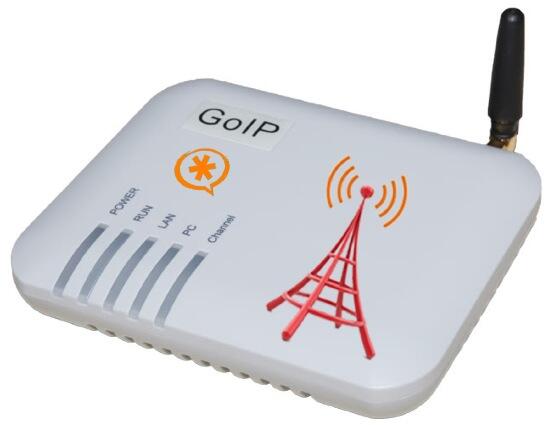
How far we have come! The original Asterisk® claim to fame was its ability to interface with proprietary phone systems and legacy telephony hardware, the glue that literally kept companies stuck to their overpriced PBXs. And, just as wired phone systems began to lose their edge, along came the Bell Sisters to introduce cellular communications with billing that began when the phone started ringing and an end to toll-free calling and extra fees for text messaging on top of exorbitantly priced data service. The piece that traditionally has been missing from Asterisk deployments has been interconnectivity with cellular data services. Well, that was then, and this is now. Meet the GoIP GSM Gateway in one, four, eight, and 16-channel flavors to meet your every need. Our focus today will be the one-channel GoIP device, but the larger units work almost identically so, once you’ve mastered the device, it’s not rocket science to move to the 4-channel or 8-channel device (or even larger) if the extra GSM ports better meet your office’s requirements.1
Let’s begin with the basics. What does it do? What does it cost? Why do I need it? How steep is the learning curve?
What Does It Do? In a nutshell, GoIP is a SIP-talkin’ GSM gateway that sits on the same network as your Asterisk server. Once you configure a trunk and a few special Asterisk settings to support SMS messaging, you’ll have another full-featured provider for your PBX, only this one happens to be GSM cellular-based. The good news is GoIP brings to your PBX most of the same feature set that is available using your favorite GSM cellphone except now every extension on your PBX in a Flash™ server can share the cellular connection both for calls and messaging. That means inbound and outbound cell calls as well as inbound and outbound SMS messaging for every extension on your PBX.
With today’s Nerd Vittles additions, here’s the new feature set using a GoIP device from any extension on your PBX:
- Make outbound calls through the GoIP cellular trunk from any PBX extension
- Receive incoming cellular calls and redirect them to any number on your PBX
- Dictate text by phone and deliver SMS messages to any SMS-capable device
- Use a browser to create and deliver outbound SMS messages to any SMS device
- Receive incoming SMS messages and forward the messages to any email address
- Receive incoming SMS messages and forward the messages to any SMS number
- Send an SMS message with a password and receive a callback with DISA dialtone
What Does It Cost? As much as we love Amazon for its referral revenue support of our blog and open source projects, we couldn’t find a single-channel GoIP offering at a reasonable price. The Amazon links provided above for the larger units are competitive (about $100 per port). For the single-channel model, eBay® is your friend. You’ll find multiple providers in the $150 price range. All of the units we’ve found ship from China. We used this provider who got the GoIP device to us exactly 14 days after we ordered it. Ours shipped with the latest firmware, but firmware updates are available here. AliExpress also sells the devices for about the same price. We’ve had good luck with them in the past.
The other expense with the GoIP devices is cellular service. For each channel, you’ll need a GSM SIM card just like what your GSM, AT&T, or T-Mobile cell phone uses. The good news is there are lots of other choices now. See WalMart for some options. Another option for low frequency use would be T-Mobile’s pay-by-the day plans. The $1 (unlimited SMS messaging) or $2/day (unlimited calls and unlimited SMS messaging) plans are almost perfect since you don’t need data. Just be sure to choose a GSM carrier, AT&T or T-Mobile in the U.S. market. Both are supported by StraightTalk. Our favorite remains the (almost) unlimited calling, text, and data $45 plan from StraightTalk. With their AT&T-compatible SIM (don’t buy it in a StraightTalk-locked phone!), it’s a simple matter of moving the SIM card from your cellphone to the GoIP’s GSM slot (connectors facing down). The GoIP unit can spoof an IMEI for picky providers.

Why Do I Need It? The two major advantages of adding a cellular trunk to your PBX are redundancy and portability. Except in the Hurricane Katrina situation, chances are that your Internet service provider and your cellular provider won’t both be dead in the water2 at the same time. The good news is that even with a hurricane, you can pack up your PBX in a Flash server or Raspberry Pi together with your GoIP device and move to higher ground. As fast as you can say "George Bush is a compassionate conservative," you’ll be back in business.
And then there are the mobile users such as construction site workers, mobile firefighters deployed to a site far from home and other first responders, or even the nomads that manage conventions in a different town every week. Think AstriCon! Rather than relying on crappy hotel WiFi service or paying an arm and a leg for installation of cable or DSL Internet service which often isn’t available anyway, now you have the flexibility to deploy a full-featured PBX at almost any temporary site with nothing more than a $30 Wi-Fi firewall/router, a PBX in a Flash Server or Raspberry Pi, and a GSM SIP trunk courtesy of GoIP. The only other ingredient you need is a little electricity. That could be a wall outlet, or a generator, or an inexpensive AC inverter for your vehicle. Did we mention it’ll work identically on the next site without spending an extra nickel. Hardware cost for the Mobile Communications Center (as shown below): about $250.
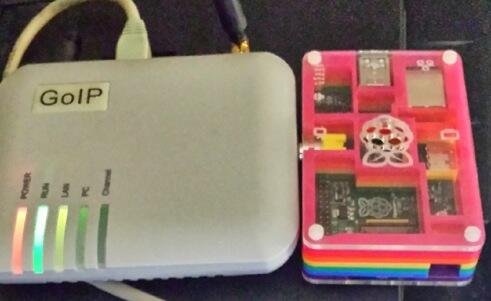
Last but not least are all of the organizations that could benefit from an SMS-based emergency messaging service. A dollar a day is a small price to pay to deploy a service that can alert the public, employees, or parents and students of emergency situations. Before you read about the next mass shooting or midnight tornado, give it some thought. We’ve already introduced SMS Blaster to make the job easy. Or you can roll your own by building a simple text file in /tmp/callees.txt with a 10-digit3 callee’s phone number on each line. Then add the following snippet to your Asterisk dialplan code and put your emergency message in line 2. You’ve just replaced a $100 a month message blasting service with a totally portable, self-managed solution. And you’ll recover your hardware costs in less than three months.
[goip-sms-blaster]
exten => s,1,Answer
exten => s,n,Set(SMSMSG="Here is where your emergency message goes.")
exten => s,n,ReadFile(callees=/tmp/callees.txt)
exten => s,n,Set(callees=${URIENCODE(${callees})})
exten => s,n,Set(callees=${REPLACE(callees,%0A,-)})
exten => s,n,Set(SMSNUM=${callees:0:10})
exten => s,n,While($[${LEN(${SMSNUM})}>9])
exten => s,n,NoOp(Here's where we send SMS message to: ${SMSNUM})
exten => s,n,Set(SMSOUT=${SMSNUM}%0A${SMSMSG})
exten => s,n,Set(SMSOUTRAW=${URIDECODE(${SMSOUT})})
exten => s,n,Set(MESSAGE(body)=${SMSOUTRAW})
exten => s,n,MessageSend(sip:goip_1)
exten => s,n,Set(callees=${callees:13})
exten => s,n,Set(SMSNUM=${callees:0:10})
exten => s,n,Set(SMSNUM=${REPLACE(SMSNUM,-,0)})
exten => s,n,EndWhile()
exten => s,n,Hangup()
How Steep Is the Learning Curve? Lucky for you, you’re not going to have to worry about the learning curve. After all, that’s why you come to Nerd Vittles, isn’t it? We’ve spent the better part of a week getting the GoIP to sit up and bark. If you’re a slow typist, it might take you 10 minutes to get everything set up and functional once you have your GoIP device and SIM card in hand. When we’re finished, you’ll have an easy way to make and receive calls through your GoIP device using any extension on your PBX. And you’ll have a simple utility to send and receive SMS messages. In fact, you’ll be able to dictate your SMS messages from any phone connected to your PBX and send them out to any number supported by SMS including the millions of Google Voice numbers. Last but not least, we’ll provide a utility to send password-protected SMS messages to GoIP and receive a return call with DISA dial tone to make outbound calls using any available trunks on your PBX.
A Word About Security. We’re a little paranoid when it comes to security so bear with us. Without impugning anyone’s integrity, suffice it to say this device is manufactured in China. Although the device reportedly runs Linux, none of its other firmware is open source, at least not that we could find. There also are three back doors into the system which can be triggered by SMS commands to the device itself. These are well documented in the GoIP User’s Manual. Whether there are other backdoors or whether the device "phones home" are questions we have neither the time nor the money to explore. Unless you do, you are well advised to treat the device in the same way you would treat a new employee on their first day at work. Don’t put the device on a private LAN in which other computers or devices on the LAN are not protected. Don’t use a SIM card with an automatic renewal feature or with authority to post charges against your credit or debit card. Change your Admin password to the device immediately. Don’t use a password you use elsewhere! Anyone can reset the device to factory defaults by knowing the default credentials and sending RESET admin in an SMS message to the device. We love the device, but be careful.
Initial Setup of the GoIP Device
To begin, you’ll need cellphone coverage in the place where you intend to connect your GoIP device. Verify this while the SIM card you plan to use is still installed in a working cellphone. Make a call and send an SMS message to verify that the site is appropriate. Next, verify that you have a place to connect your GoIP device to your LAN in the same location. Both of these are important first steps, or you’ll be wasting your time continuing on. Once the connectivity issues are out of the way, turn off your cell phone, remove the GSM SIM card, and insert it into the GoIP device with the connectors pointing downward. You should hear a click when the SIM card is properly seated. Now connect the device behind a hardware-based firewall/router that provides DHCP service. Plug an Ethernet cable into the LAN port of the GoIP device and connect it to your network. Finally, using the power adapter provided, apply power to the device. Watch the blinking lights. While booting the RUN light will flash on and off every 100 milliseconds. Once the RUN and CHANNEL lights flash GREEN once per second, you’re in business. Now use another cellphone to send a text message with the word INFO to the phone number associated with the SIM card you plugged into the GoIP Device. You should receive a return message telling you the DHCP LAN address associated with the GoIP CHANNEL port where you plugged in the SIM card. Write it down! We’re not going to use the PC port so you can ignore its IP address for now.
Asterisk Prerequisites for Today’s GoIP Project
We’ll be using PIAF-Green with Asterisk 11 and FreePBX 2.11 today so you’ll have to read between the lines if you’re using a prehistoric release or a non-FreePBX system. We’re also assuming you’ve installed Incredible PBX™ 11 which provides the necessary components to get Google’s text-to-speech and speech-to-text features working. If you’d prefer to roll your own, then start by installing Lefteris Zafiris’ GoogleTTS and Speech Recognition components for Asterisk. For PBX in a Flash users that aren’t using Incredible PBX, you can follow this tutorial to install all of the necessary components in one click.
Initial Setup of FreePBX for the GoIP Device
We’ve found that it’s easier to configure the FreePBX® side to support the GoIP, and then configure the GoIP unit. There are seven simple steps. If you don’t want SMS DISA callback support in your setup, skip the last two steps.
- Add GoIP SIP Trunk
- Add Custom SIP Settings
- Add GoIP Outbound Route
- Add GoIP Custom Destination
- Add GoIP Misc Application
- Add GoIP DISA Context
- Add GoIP DISA Misc Application
1. Start by adding a new SIP Trunk to support the GoIP device. Be sure to match the device names we’ve shown exactly, or nothing will work. Our special thanks to samyantoun for his initial work on this. Replace 192.168.0.107 with the IP address of your GoIP. Replace 77 with whatever dialing prefix you want to use to make calls through the GoIP trunk. And add the phone number associated with your GoIP in the Outbound CallerID field. If you’re using the GoIP device behind a hardware-based firewall with no Internet port exposure, then you can leave password as the secret. Otherwise, you would want something very secure!4
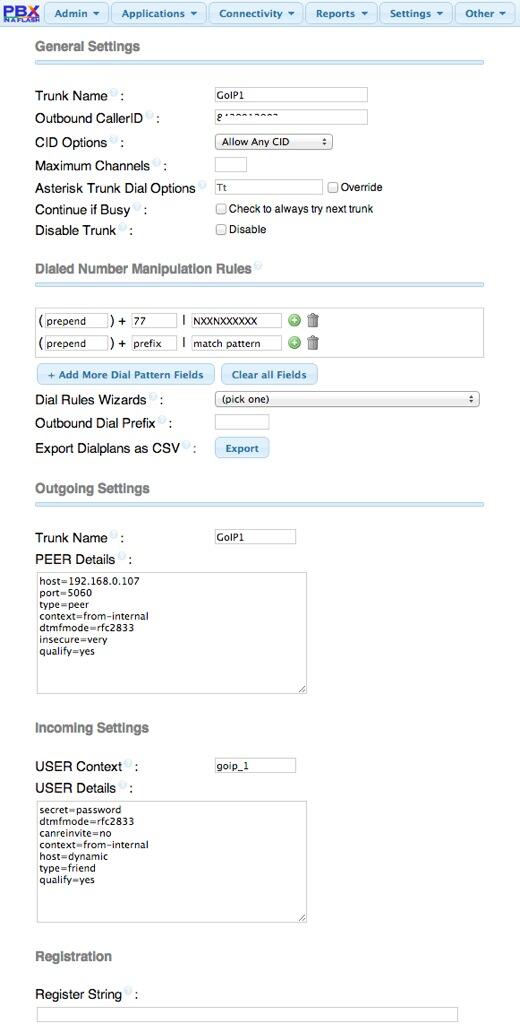
2. Add a couple of custom SIP entries at the bottom of Asterisk SIP Settings to support SMS messaging with Asterisk. Set accept_outofcall_messages=yes and outofcall_message_context=sms_message. Then Submit Changes.

3. Add an Outbound Route to make calls using your GoIP device using the dial prefix you chose for the trunk:
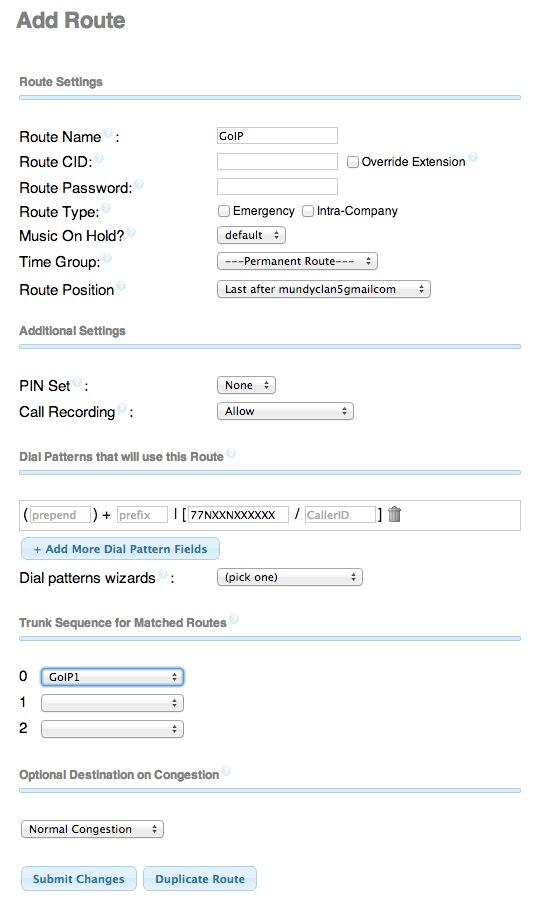
4. Next we need to add a FreePBX Custom Destination to support the Nerd Vittles speech-to-text module which we’ll be using to dictate and send SMS messages using any telephone on your PBX. Under Admin -> Custom Destination, add an entry that looks like this:
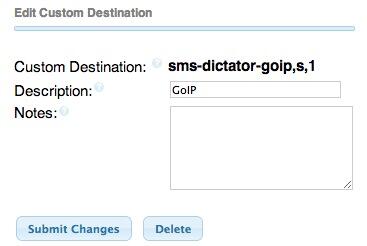
5. Then we need to associate an extension number with the custom destination we just added. We’ve chosen 4647 which spells GoIP. Choose Applications -> Misc Application and enter the following:
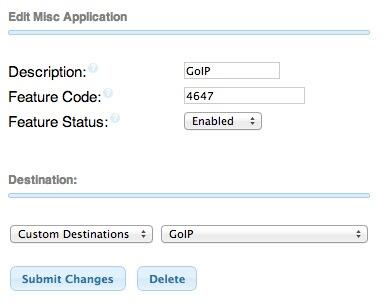
6. DISA is an Asterisk function that lets someone call into your PBX and obtain dial tone to place an outbound call using the available trunks on your PBX. In the case of the GoIP device, this gets a little fancier. We’ll actually be sending an SMS message with a custom password to the GoIP device, and it will in turn call the SMS sender’s number and provide DISA dialtone after the user enters a special DISA PIN. Make the PIN and password very secure. We’ll get to the password in a minute. On the FreePBX side, add a DISA context in FreePBX under Applications -> DISA that looks something like the following with a secure PIN (not the one in the example):
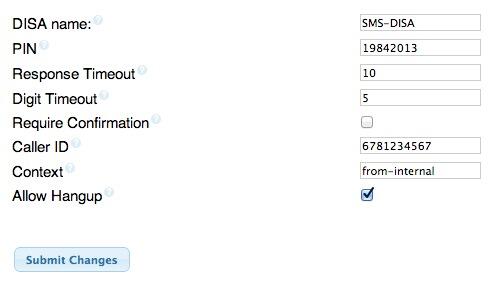
7. In order to use DISA with GoIP, we’ll need an extension associated with the DISA function. We add this number using FreePBX Misc Application. You can use any available extension number you like. Just remember what you chose when we configure the GoIP side to support SMS DISA access. Here’s what we use:
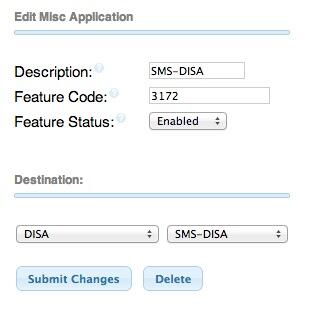
Configuration of the GoIP Device
All of the GoIP device configuration is handled using a browser pointed to the internal IP address of the GoIP. If you haven’t already done so, send an SMS message with the word INFO to the phone number associated with your GoIP device. You will get a return message with the private IP address of the unit. Using a browser, point it to the IP address and login with username admin and password admin. It’s probably a good idea to reset your unit to factory defaults before beginning the setup just to make sure you’re starting with a clean slate. Send an SMS message to the device with the words RESET admin to initialize the hardware.
As we’ve mentioned, sending the admin password to the device with the RESET keyword forces a total reset of the device so you obviously want to change this admin password immediately unless you want to risk a total stranger sending a reset command to your device. Do it now under Tools -> Change Password -> Administration Level. It’s probably a good idea to change the other passwords as well.
Next, click Configurations. This is the screen on which you set everything. The Preference pane has the country-specific settings for both the network and your cellphone carrier so set them carefully. The IMEI will default to the actual IMEI of your unit. If your cellphone carrier requires registration of a specific IMEI before your SIM card will work, then you can spoof the IMEI using the IMEI of the cell phone that was previously used with this SIM card. For the East Coast of the United States, our setup looks like this:
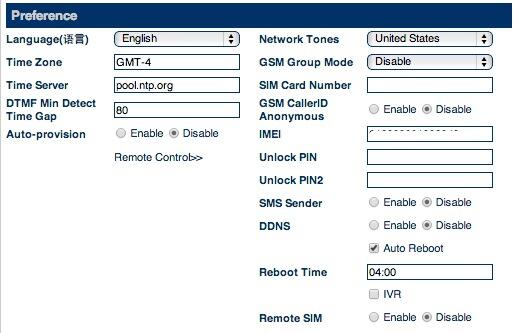
If you’re using DHCP for the GoIP, the Network Configuration pane shouldn’t require any changes. We do recommend that you lock the DHCP address to the GoIP in your router so that it doesn’t inadvertently change down the road. You will note that a PPTP VPN tunnel for the device is supported although we haven’t yet played with it.
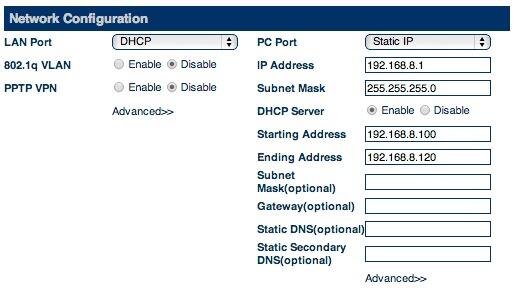
The Call Settings pane has all of your SIP settings for the GoIP. These have got to be right or nothing will work. Our setup (that works) is shown below. Start by clicking on each of the Settings and Preferences links to open up the sub-menus. Both 192.168.0.180 entries should be replaced with the IP address of your Asterisk server. The Phone Number and Authentication ID both need to be goip_1 as shown. The password is password unless you changed your secret in the FreePBX trunk setup. DTMF Signaling should be changed to Outband and DTMF Type should be RFC2833. Ours still doesn’t work reliably, but that may be the lousy cellphone signal in our office. We recommend ULAW and ALAW exclusively for the Audio Codecs. You don’t want the overhead of codec translation particularly if you’re using a Raspberry Pi. On a normal server, G.729 would obviously reduce the bandwidth of GoIP voice calls. Get it working first and then experiment! The RTP port range should be 10000-20000 to match your Asterisk default setup.
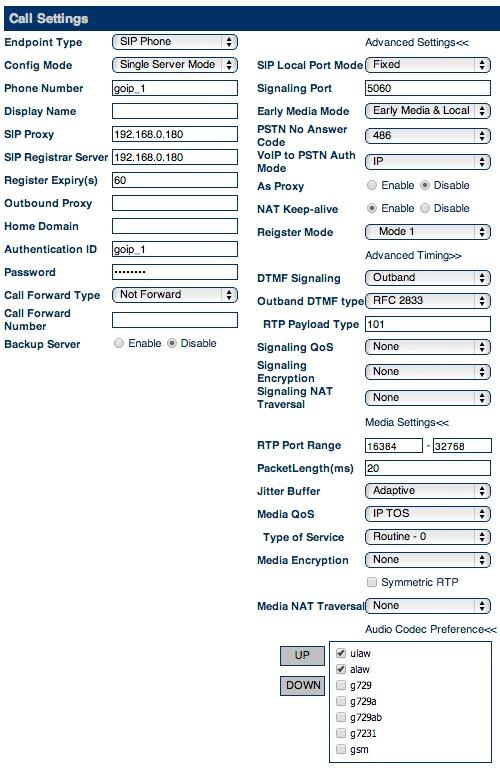
The Call Divert pane is where we configure all of the Nerd Vittles magic. Forward Number(PSTN To VoIP) should be the number on your PBX to which you want inbound GoIP calls forwarded when someone calls the cellphone number associated with your GoIP device. This could be an extension, ring group, IVR, or even the DISA number we set up above. Just be sure you have a verrrrrry secure DISA PIN if you go this route! It’s your phone bill. The SMS Mode must be changed to Relay, and SMS Forward SIP Number must be s to work with the Nerd Vittles apps.
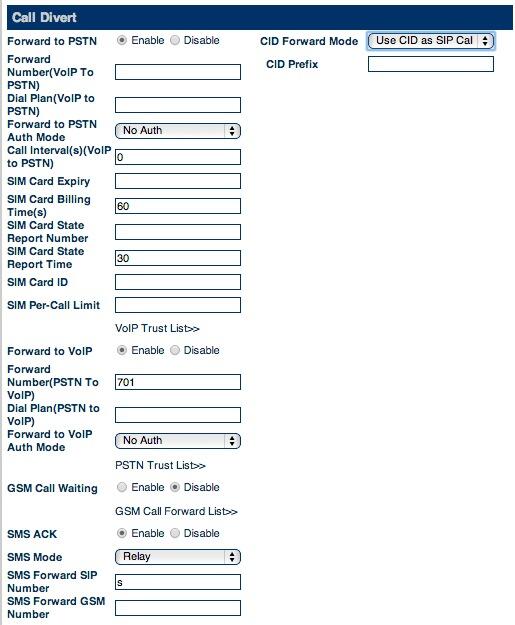
Once you have all of your settings entered, click the Save Settings link under Configurations. The unit will reload its SIP setup. It usually takes about 30 seconds. We recommend you now test the setup to make sure you can make a call to the GoIP number and have it forwarded to an extension on your Asterisk server. Then use an extension on your PBX to place an outbound call using the GoIP dial prefix you assigned above. If either call fails, check your settings for typos in both the FreePBX and GoIP configurations.
Adding the Nerd Vittles Apps to Support the GoIP Device
Now for the fun stuff. We’ve built a little shell script that sets up all of the Nerd Vittles applications we outlined above. It’s licensed as GPL2 code so you are more than welcome to make any changes or additions which you believe would be useful. We hope you’ll share them with the rest of us. The script puts everything in the proper place on Incredible PBX systems to support SMS messaging with Asterisk. You’ll be prompted for the following information:
- Email address to which to forward incoming SMS messages
- SMS number to which to forward incoming SMS messages
- Very secure password to trigger PBX callbacks
- Extension number to ring on callbacks
1. When incoming SMS messages are received by the GoIP unit, Asterisk will forward them to this email address.
2. When incoming SMS messages are received by the GoIP unit, Asterisk will forward them to this SMS number. You can disable either the forwarding email address or the forwarding SMS number (not both!) by editing the [sms_message] context in extensions_custom.conf and commenting out either of these lines with a semicolon:
exten => s,n,system(echo "SMS Message From ${SMSDID}: ${SMSMSG}"...exten => s,n,MessageSend(sip:goip_1)
3. This password is what must be sent as an SMS message to the GoIP device to trigger a return call from Asterisk. Do NOT include any spaces in the password and make it very secure!
4. This is the extension number that will be used to place the return call from Asterisk. For DISA service, it would be 3172 in today’s setup. It could also be a regular extension on your PBX if you simply want to trigger a return call from your home or office extension when you send this password via SMS to the GoIP device. Note that the home or office extension must answer the call before the return call will be placed to your SMS device or phone.
Installation. To install the components (a one-minute job!), log into your server as root and issue the following commands:
cd /root
rm GoIP-install.sh
wget http://incrediblepbx.com/GoIP-install.sh
chmod +x GoIP-install.sh
./GoIP-install.sh
If you ever need to make changes to your setup, just run the script again and answer the prompts.
Kicking the Tires. To make sure everything is working, try sending an SMS message to the GoIP with your secret password from #3 above. You should get a return call within 30 seconds. Next, from an extension on your PBX, dial 4647. Dictate a brief message and then enter a phone number for delivery of the message via GoIP to some SMS device (not your GoIP unit!). Finally, send a "Hello World" SMS message to your GoIP device. It should be forwarded to both your email address (#1) and SMS number (#2) within a few seconds. Enjoy!
Deals of the Week. There’s still an amazing deal on the street if you hurry. A new company called Copy.com is offering 20GB of free cloud storage with no restrictions on file size uploads (which are all too common with other free offers). Copy.com has free sync apps for Windows, Macs, and Linux systems. To take advantage of the offer, just click on our referral link here. We get 5GB of extra storage, too, which will help avoid another PIAF Forum disaster.
Originally published: Monday, September 30, 2013

Need help with Asterisk? Visit the PBX in a Flash Forum.

We are pleased to once again be able to offer Nerd Vittles’ readers a 20% discount on registration to attend this year’s 10th Anniversary AstriCon in Atlanta. And, if you hurry, you also can take advantage of the early bird registration discount. Here’s the Nerd Vittles Discount Code: AC13NERD.
Special Thanks to Our Generous Sponsors
FULL DISCLOSURE: ClearlyIP, Skyetel, Vitelity, DigitalOcean, Vultr, VoIP.ms, 3CX, Sangoma, TelecomsXchange and VitalPBX have provided financial support to Nerd Vittles and our open source projects through advertising, referral revenue, and/or merchandise. As an Amazon Associate and Best Buy Affiliate, we also earn from qualifying purchases. We’ve chosen these providers not the other way around. Our decisions are based upon their corporate reputation and the quality of their offerings and pricing. Our recommendations regarding technology are reached without regard to financial compensation except in situations in which comparable products at comparable pricing are available from multiple sources. In this limited case, we support our sponsors because our sponsors support us.
 BOGO Bonaza: Enjoy state-of-the-art VoIP service with a $10 credit and half-price SIP service on up to $500 of Skyetel trunking with free number porting when you fund your Skyetel account. No limits on number of simultaneous calls. Quadruple data center redundancy. $25 monthly minimum spend required. Tutorial and sign up details are here.
BOGO Bonaza: Enjoy state-of-the-art VoIP service with a $10 credit and half-price SIP service on up to $500 of Skyetel trunking with free number porting when you fund your Skyetel account. No limits on number of simultaneous calls. Quadruple data center redundancy. $25 monthly minimum spend required. Tutorial and sign up details are here.
 The lynchpin of Incredible PBX 2020 and beyond is ClearlyIP components which bring management of FreePBX modules and SIP phone integration to a level never before available with any other Asterisk distribution. And now you can configure and reconfigure your new Incredible PBX phones from the convenience of the Incredible PBX GUI.
The lynchpin of Incredible PBX 2020 and beyond is ClearlyIP components which bring management of FreePBX modules and SIP phone integration to a level never before available with any other Asterisk distribution. And now you can configure and reconfigure your new Incredible PBX phones from the convenience of the Incredible PBX GUI.
 VitalPBX is perhaps the fastest-growing PBX offering based upon Asterisk with an installed presence in more than 100 countries worldwide. VitalPBX has generously provided a customized White Label version of Incredible PBX tailored for use with all Incredible PBX and VitalPBX custom applications. Follow this link for a free test drive!
VitalPBX is perhaps the fastest-growing PBX offering based upon Asterisk with an installed presence in more than 100 countries worldwide. VitalPBX has generously provided a customized White Label version of Incredible PBX tailored for use with all Incredible PBX and VitalPBX custom applications. Follow this link for a free test drive!
 Special Thanks to Vitelity. Vitelity is now Voyant Communications and has halted new registrations for the time being. Our special thanks to Vitelity for their unwavering financial support over many years and to the many Nerd Vittles readers who continue to enjoy the benefits of their service offerings. We will keep everyone posted on further developments.
Special Thanks to Vitelity. Vitelity is now Voyant Communications and has halted new registrations for the time being. Our special thanks to Vitelity for their unwavering financial support over many years and to the many Nerd Vittles readers who continue to enjoy the benefits of their service offerings. We will keep everyone posted on further developments.
Some Recent Nerd Vittles Articles of Interest…
- Some of our purchase links refer users to Amazon when we find their prices are competitive for the recommended products. Nerd Vittles receives a small referral fee from Amazon to help cover the costs of our blog. We never recommend particular products solely to generate Amazon commissions. However, when pricing is comparable or availability is favorable, we support Amazon because Amazon supports us. [↩]
- With apologies for the tasteless photo and pun. [↩]
- The length of the phone numbers obviously can be adjusted to meet your local requirements. Just replace the 10’s with the length of the phone numbers you wish to use. Then replace 13 with 3 more than the phone number length you chose. [↩]
- We have engineered today’s GoIP solution for users in the U.S. and Canada. It obviously will support international deployment as well by making adjustments to the dial strings and cellphone settings in both the FreePBX and GoIP configurations. [↩]
Amerika the Beautiful: An Insider’s View of What Went Wrong and How To Fix It

UPDATE: Following a week of almost daily new disclosures, we are republishing our original article with some additional observations from us and others who have been following what will almost certainly turn out to be one of the most shocking and important revelations in the history of our republic. Much of this story has unfolded on Twitter, one of the few companies that stood up to the government and refused to participate in the PRISM data collection enterprise. So it seemed only fitting to retell the events of the last few weeks through the tweets that have brought this story to life and fleshed out many of the details pertaining to Mr. Snowden’s original revelations. –Ward Mundy
#FISA 4th Amendment: Seize Everything, Search When You Want To, Then Tell Us What You Found Next Month. Really? #NSA pic.twitter.com/ne6Q2dyijB
— Ward Mundy (@NerdUno) June 20, 2013
As the cellphone and NSA scandals continue to unfold, we’ve wrestled with a number of emotions probably much as many of you have. This isn’t so much a liberal versus conservative controversy as it is a question about what type of society we all want for our families and for those that will come after us. Having grown up in a military family, I came in contact with individuals from literally all walks of life, commanding generals to sergeants and privates. Most did their jobs very well and took pride in their accomplishments and those of others. After high school, I attended Auburn University and then went on to law school at the University of Alabama, two schools known more for their football teams than their academic credentials. Even though the country was in the midst of the George Wallace era of states’ rights, I actually got a well-balanced legal education at Alabama. Much to the chagrin of the governor, many of my law professors were Yankees from the most liberal bastions in our country including Harvard and Yale. So it was probably not surprising that more than half of my law class of 130 became card-carrying liberals. In fact, I only remember one ultra-conservative classmate, and we never were sure whether he believed all the things he was saying or was just doing it for attention and to establish his pedigree for future political races.
We were up to our eyeballs in Vietnam when I graduated so my career path was chosen for me. Those with political connections and those from well to do families got to join the National Guard and stay home. The rest of us got drafted. If you were a lawyer, you had the choice of serving two years as an infantry officer or four years as a lawyer. That was an easy choice at least for me because I owed the military four years anyway because of a college scholarship. There was a great book at the time, Military Justice is to Justice as Military Music is to Music. You really didn’t have to read the book to figure out the message. As an appellate lawyer, I got to witness it up close and personal. Military courts have special rules. Military commanders decide who gets tried and then they hand-pick the military juries who also happen to be soldiers working for the same commander. If a criminal case went to trial, your odds of not being convicted were about the same as being struck by lightening or winning the lottery. The same held true for the criminal appeals. All of my clients were already serving time in Fort Leavenworth while I "represented" them in Washington. A handful saw their sentences reduced on appeal while one or two actually had their cases reversed. Despite the odds favoring the military, I actually worked for an appellate judge that would hide problematic cases in a bottom drawer until the soldier had served all his jail time. Then the case would magically reappear, and justice would be done by reversing the errors in the trial proceedings. Several of us finally filed a complaint against the judge, and he was "retired." This was my first exposure to the "Rewards System." Many folks are promoted into prestigious jobs in the government not to do future good work but as a reward for past service. In short, it’s treated more like a medal than a job. Suffice it to say, you don’t see a lot of boat rocking from the honorees.
At the time, I chalked this up as yet another military anomaly. It was reinforced by the decade I spent at all levels of the military justice system including a stint as the Court Executive of the U.S. Court of Military Appeals, the civilian court that oversaw the whole process. What was surprising to me were the extremes to which many individuals in the most important legal positions in the military were willing to go in order to rig the system in favor of what they perceived to be the desires of the military commanders. My dad had been a military commander. He and all of the commanding generals I have known would never have tolerated such a setup had they known about it. While the President technically appointed judges to the Court of Military Appeals, in actuality the judges were selected by members of the Senate Armed Services Committee. Because the Court had become too liberal for some of the senior people in Donald Rumsfeld’s Defense Department, they decided to change the name of the court to make it sound more like a real federal court. While they were at it, they expanded the number of judgeships in order to get rid of the "liberal problem." Killing two birds with one stone wasn’t hard with the enthusiastic support of Strom Thurmond and the armed services committees. They "promoted" the most liberal judge to a district judgeship with life tenure to get him out of town.
When the court packing began, I left and joined the staff of the newly created U.S. Court of Appeals in Atlanta. There I served for more than 20 years as the technology guru. During my tenure, we introduced personal computers, networks, VPNs, video conferencing, cellphones, automated case management systems, and the 20th century to many judges and lawyers that still were deciding cases in much the same way they had been handled since the founding of our country.
Unlike the military system, the federal courts were different. These judges weren’t wearing medals. They took their jobs seriously. All were appointed for life by the President, and most had come from cream of the crop positions in the most prestigious law firms and law schools in the country. Many that I worked for had single-handedly desegregated the South: its schools, its lunch counters, its water fountains, and even its bathrooms. No small feat considering there were still Ku Klux Klan signs announcing evening meetings when I would drive back to school on Sunday afternoons.
I had almost daily contact with these judges because our courts in the southeastern United States were handling caseloads at least 10 times what other courts across the country were experiencing. And, without the very best technology, these courts would literally have been buried by the paperwork associated with these legal proceedings. It began with civil rights cases, then voting rights, then drugs, then bankruptcies, then death penalties, and on and on.
But something changed at about the time Ronald Reagan became president. Many of the new judges that were appointed had come from prior government jobs. Some had been magistrates. Others had been state court judges. Many had been former federal or state prosecutors or lawyers in the Department of Justice. Some were small town lawyers who happened to serve as a community campaign manager for the president or a staff assistant to a U.S. Senator. There was even a former nun. What was different was that many of them came with an agenda. And many of the selections were more about ideology than legal accomplishment. We’ve now seen that process play out for more than 30 years. With some notable exceptions, many "medalists" have crept into the federal judiciary at all levels. Free resort junkets for judges sponsored by organizations with their own agenda are all too common. As we saw in the military setting, the perks of the office and living the country club life style started mattering more than doing the job. Keep in mind that these judges serve for life with almost no outside scrutiny. When you then add secret tribunals to the mix, it makes for a dangerous concoction with no checks and balances.
Secret Court and Secret Opinions emasculate the lynchpin of U.S. legal system: precedent. No Checks + No Balance = No Rule of Law #NSA #FISA
— Ward Mundy (@NerdUno) June 14, 2013
There also was a metamorphosis underway in Congress. Southern Democrats became Republicans largely because of the civil rights statutes championed by Lyndon Johnson. Southern Democrats had always held their nose and gone along with the agenda of the Democratic Party as long as separate-but-equal was left in place. When "the deal" changed, they bolted. Big business was getting a very different foothold in Congress. A law school classmate of mine who became a very prominent lobbyist on Capitol Hill once told me that there was no bill he couldn’t get passed if his client had deep enough pockets.
https://twitter.com/davidsirota/status/345686857562066944
The Oligopoly Revolution was also underway. Virtually every American industry now has less than a handful of players which has led to skyrocketing prices: Big Oil, Big Banks, Automobiles, Airplane Manufacturers, Airlines, Technology, Communications, Hospitals, Drug Manufacturers, Health Care Providers, Fast Food, Grocery Stores, Hardware Stores, and Drug Stores to name just a few. There really is no space left for the little guy and the entrepreneur. Price fixing by manufacturers now is perfectly legal. Software patents appeared out of thin air and have essentially killed off independent software development unless you work for the handful of leading technology companies that can afford a patent portfolio.
I totally misunderstood when AT&T and Verizon said they were moving to shared data plans.
— Ina Fried (@inafried) June 7, 2013
And then there was 9/11. In response to the threat of terrorism and under the convenient umbrella of national security, Congress has all but repealed the constitutional protections laid out in the Bill of Rights while establishing a National Security Agency that would have been the envy of Adolph Hitler and Joseph Stalin. The "new" federal courts have routinely rubber-stamped every piece of this legislation. And then came the secret FISA court with secret proceedings and secret decisions and secret court orders and no public appeals. If you read nothing else, read this article in The Verge. Here’s an excerpt:
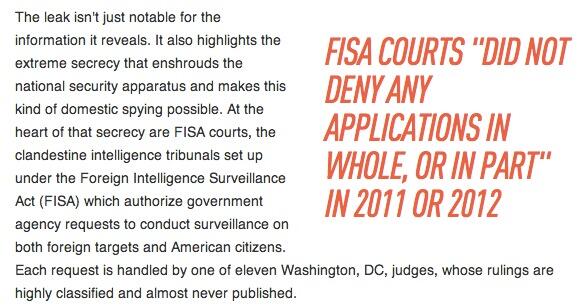
The 9/11 terrorists should be proud. They have single-handedly changed our entire security apparatus (not to mention our judicial system) to one that looks frighteningly similar to what you would find in Pakistan, China, or North Korea. And the response from the President and Congress… "Gosh, we’re all so much more secure when we can identify the calling history of every single cellphone user and can intercept every email communication in the universe." And the American Technology Oligopoly appears to have gone right along with it while lying their asses off about what has happened. Who needs the keys to your house? They’ve already got access to every piece of personal data you create!

We obviously hope some of this story turns out not to be true, but then there’s this:
News Flash: Everything Snowden said about analyst listening to phone calls turns out to be true after all http://t.co/aZjxxYyM4i #NSA #PRISM
— Ward Mundy (@NerdUno) June 16, 2013
The problem is that Congress and some within the judiciary have so tilted the playing field that it’s hard to have much faith in any of our public institutions any more. Just to reemphasize, this has nothing to do with Democrats or Republicans. It has to do with almost all of our national politicians who have sold themselves out to the highest bidder.
Recomano: "Privacy Isn't All We're Losing. The surveillance state threatens Americans' love of country" > http://t.co/Cr8fAGjRa6 #nsa
— Toni Piqué ن (@ampique) June 14, 2013
So how do we fix this mess? For the short term, stop using browsers to generate or read email. Encrypt your email and stop using Gmail, HotMail, and Yahoo. Use VPNs for communications whenever possible. And Silicon Valley needs to take a careful look in the mirror. They are a major part of the problem.
Add a #VPN Layer of Protection Between YeaLink and the #NSA: Here's How http://t.co/syT4musew3 #asterisk #voip pic.twitter.com/xKEgdMuHLj
— Ward Mundy (@NerdUno) June 20, 2013
Then it’s time to take our country back. Those of us that continue to sit on the sidelines deserve what we get.
We share the sentiments and recommendations of Hendrik Herzberg in The New Yorker:
Calling for a national commission can be the last refuge of the high-mindedly perplexed, but this is one instance when such a commission—independent, amply funded, possessing subpoena power, and with a membership and a staff deeply versed in both national security and civil liberties—may be precisely what is needed. The N.S.A. programs represent a troubling increase in state power, even if—so far, and so far as we know—they have not occasioned a troubling increase in state wrongdoing. Obama’s “difficult questions” have a new urgency. Are the programs truly efficacious? Do they truly provide an extra margin of safety sufficient to justify the resources poured into them, to say nothing of the domestic and international anxieties they inevitably provoke? Is it wise to entrust so many of their activities to the employees of private companies, which are ultimately answerable not to the United States and its Constitution but to corporate stockholders? Did it make sense to construct an intelligence behemoth that apparently cannot operate without giving an enormous number of people—more than a million—top-secret security clearances? And in what ways, exactly, might an ill-intentioned yet formally law-abiding Administration use its powers for nefarious purposes? From what we know so far—well, we know far too little, still.
Finally, let us close by pointing you to Steve Wozniak’s commentary on this mess. We couldn’t have said it better…
https://twitter.com/declanm/status/346512577355980800
Originally published: Sunday, June 9, 2013
The Good, The Bad, and The Ugly: 2013 Cellphone Navigation Guide

Every year or so we like to take a fresh look at the cell phone landscape and reassess what makes the most sense for business, personal, and family use in terms of cost, functionality, and performance. Last year’s favorite based upon both cost and feature set was StraightTalk which offered unlimited talk, text, and data (sort of) on either the AT&T or T-Mobile network for $45 a month. Since that article was released, StraightTalk has quietly dropped the AT&T offering reportedly at AT&T’s request due to reported changes in the phone unlocking law. To date, existing StraightTalk users of the AT&T service have not been affected. Whether that will continue, of course, is anybody’s guess. Suffice it to say, when you could get identical or better functionality from StraightTalk for less than half the cost of buying directly from AT&T, customers were leaving AT&T in droves. So this may be nothing more than an attempt to stop the hemorrhaging. For those that may be interested, you still can buy an AT&T StraightTalk SIM on eBay for $30-$100.
What has also changed in the last year is the data plan landscape. Both of the Bell Sisters, AT&T and Verizon, have moved to shared data plans with unlimited talk and text. In the U.S. market, there are no more unlimited data plans except from the second tier providers, Sprint and T-Mobile. You basically pay a base fee for a bucket of data and then a per device fee for each cellphone or tablet you wish to use. It should come as no surprise that the costs are nearly identical whether you choose AT&T or Verizon. See this Engadget article for the details. If you’re a heavy consumer of data services or if you have kids that frequently stream music or movies, the pay-as-you-go shared data plans are bad news. Similarly, StraightTalk advertises unlimited data on their monthly plans but, in the fine print, bars use of any phone for tethering or any streaming services. We’ll leave it to you to decide whether this is deceptive advertising. Suffice it say, it hasn’t bothered the Federal Trade Commission thus far.
So what is a heavy cellphone data user to do? For the moment, there is a solution, but who knows what the future holds. Verizon has grandfathered in those customers who previously had $29.95 unlimited data plans, and this applies to 3G and 4G data services. For $30 more a month, you also can add tethering with unlimited data. For the record, if this sounds expensive to you, keep in mind that Verizon’s latest MiFi JetPack pricing for 10GB of data per month is a whopping $90. The only condition (thus far) for keeping an unlimited data plan is that customers cannot take advantage of new phone subsidies when renewing or extending a contract. But customers are free to purchase a new phone at full price and transfer an existing unlimited data plan account to the new phone. More importantly, for those of us not on a Verizon unlimited data plan, there is no restriction on transferring an existing account to someone else. It should come as no surprise that clever, long-time Verizon customers quickly started selling their unlimited data plan accounts on eBay. And we bought one to determine whether the transfer process actually works. It does!

Before we get to the details, we’ve got to share our latest Best Buy adventure to purchase the new Samsung Galaxy S4 which we will review in a few weeks. As with previous episodes, we continue to swear we’ll never again set foot in a Best Buy store. Here’s why. Thinking we’d save a little time, we ordered the GS4 on line at bestbuy.com with delivery to our local store. The site showed the store had the units in stock. Within minutes, we got an email confirmation that the order had been received. The original email noted that we would receive another email when the phone was ready for pickup but also included a link to actually schedule a pickup time. Certain times were blocked out, and we picked an available time slot which was roughly four hours after the phone had been purchased. So far, so good.
Silly us, we thought scheduling a pickup time might actually bear some relationship to the ordering procedure. It didn’t. When we arrived at the store, the customer service rep indignantly insisted that we had arrived too soon. The approval process had not been completed despite the fact that PayPal already had approved the transaction. The Best Buy web site actually showed that the order was awaiting confirmation (from the store) that the phone was in stock. The store employees claimed no knowledge of such a request. When would the process be completed? We were told it usually happened almost instantly, but this was "an expensive phone." Who knows? Four hours later, there still was no confirmation email. Because we were leaving town, the on line order was cancelled, and we returned to the Best Buy store to purchase the phone directly. The Verizon SIM card was an additional $20. The salesperson slipped it into the bag with the phone. Hours later, we discovered that Best Buy had taped a different SIM chip onto the credit-card sized card that usually contains both the SIM chip and the SIM card device ID. Because they didn’t match, we suspected that someone had returned a defective SIM card, and Best Buy had swapped out the bad SIM chip for the original one on the card. Guess where the bad one went? We’ll never know because we didn’t want to take a chance since we needed a working SIM card to complete the Verizon transfer procedure. Trip #3 to Best Buy plus an online order and a cancelled online order minus $823 for a phone, $290 to eBay, and $10 for gasoline, and we finally had all the pieces. Never again. Honest! In her usual sympathetic voice, my wife inquired, "How does Best Buy stay in business?" I responded that the stores were convenient. She reminded me that the process recounted above was anything but convenient. Amen.
If you decide you want a Galaxy S4, do yourself and Nerd Vittles a favor. Use the link in the right column to head over to Amazon. You’ll not only avoid the Best Buy aggravation, but you’ll save over $170 in the process while providing a little financial support to the Nerd Vittles project. If you’re a Prime member, you even get free 2-day shipping. Don’t forget to purchase a Verizon 4G SIM card. They’re $4 at Amazon instead of $20 at Best Buy. 🙄
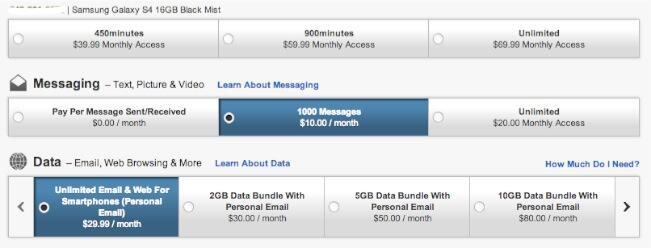
When we purchased the grandfathered data plan on eBay, the seller had indicated that the plan would not be available for transfer for a couple of days. What we were told we needed was the IMEI of the phone plus the SIM card ID. Actually, you need a few more things unless you have an existing Verizon account. Remember, you have to pass a credit check to get Verizon service. And this requires your name, social security number, date of birth, home address, and phone number. In short, it’s everything anybody would want that was interested in identity theft. We have credit monitoring services so we weren’t too worried. If you don’t, you probably shouldn’t repeat the procedure we used since you’ll be on the phone with both the eBay seller AND the Verizon rep that’s handling the account transfer. Ideally, a seller should be able to provide you the cellphone number associated with the account, and you could provide the IMEI and SIM card ID to the seller for relaying to Verizon. Then you could call Verizon directly, plug in the cell phone number, and complete the transfer and credit check. This avoids the potential man-in-the-middle problem. In any case, the process was effortless. Changing the phone device and phone number on the account was a breeze. We chose a Calling Plan and Messaging Plan to go with the Unlimited Data Plan, and we were off to the races. Available plan pricing is shown above.
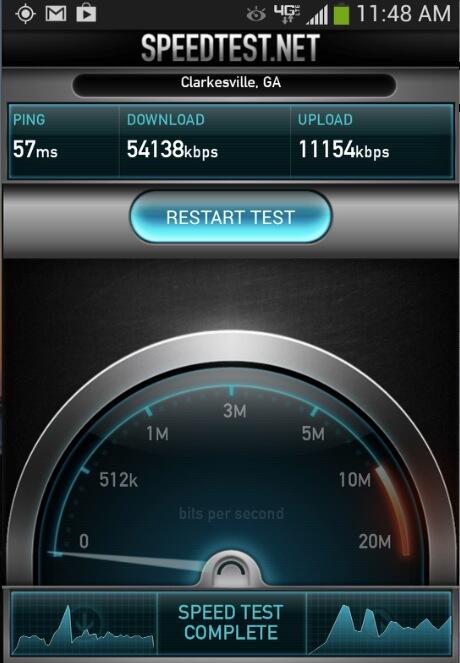
Still wondering why unlimited data with 4G LTE service matters? Take a gander at the performance numbers above from one of the most remote areas in the Smoky Mountains of North Carolina, and the answer should be obvious. Waynesville is a town with a population of under 10,000 people. Impressive indeed, Verizon!
Pioneer Alert. We’re pleased to announce the release of the new PIAF-Green Virtual Machine with PBX in a Flash 2.0.6.4.4, Asterisk 11, and FreePBX 2.11. This version incorporates important security updates including a new Linux kernel and patches to protect against the Apache SSL attacks plus the latest Google Voice Motif additions for Asterisk and FreePBX. Grab a copy to play with on your Windows, Mac, or Linux desktop. You can download it now from SourceForge and provide feedback in the PIAF Forum. Documentation is provided both in the SourceForge readme and in the Nerd Vittles article covering the previous release. We’ll have a new tutorial available next week on Nerd Vittles.
Deals of the Week. There are a couple of amazing deals still on the street, but you’d better hurry. First, for new customers, Sangoma is offering a board of your choice from a very impressive list at 75% off. For details, see this thread on the PIAF Forum. Second, a new company called Copy.com is offering 20GB of free cloud storage with no restrictions on file size uploads (which are all too common with other free offers). Copy.com has free sync apps for Windows, Macs, and Linux systems. To take advantage of the offer, just click on our referral link here. We get 5GB of extra storage, too, which will help avoid another PIAF Forum disaster.

Originally published: Thursday, June 6, 2013

Need help with Asterisk? Visit the PBX in a Flash Forum.
Or Try the New, Free PBX in a Flash Conference Bridge.
whos.amung.us If you’re wondering what your fellow man is reading on Nerd Vittles these days, wonder no more. Visit our new whos.amung.us statistical web site and check out what’s happening. It’s a terrific resource for all of us.
Special Thanks to Our Generous Sponsors
FULL DISCLOSURE: ClearlyIP, Skyetel, Vitelity, DigitalOcean, Vultr, VoIP.ms, 3CX, Sangoma, TelecomsXchange and VitalPBX have provided financial support to Nerd Vittles and our open source projects through advertising, referral revenue, and/or merchandise. As an Amazon Associate and Best Buy Affiliate, we also earn from qualifying purchases. We’ve chosen these providers not the other way around. Our decisions are based upon their corporate reputation and the quality of their offerings and pricing. Our recommendations regarding technology are reached without regard to financial compensation except in situations in which comparable products at comparable pricing are available from multiple sources. In this limited case, we support our sponsors because our sponsors support us.
 BOGO Bonaza: Enjoy state-of-the-art VoIP service with a $10 credit and half-price SIP service on up to $500 of Skyetel trunking with free number porting when you fund your Skyetel account. No limits on number of simultaneous calls. Quadruple data center redundancy. $25 monthly minimum spend required. Tutorial and sign up details are here.
BOGO Bonaza: Enjoy state-of-the-art VoIP service with a $10 credit and half-price SIP service on up to $500 of Skyetel trunking with free number porting when you fund your Skyetel account. No limits on number of simultaneous calls. Quadruple data center redundancy. $25 monthly minimum spend required. Tutorial and sign up details are here.
 The lynchpin of Incredible PBX 2020 and beyond is ClearlyIP components which bring management of FreePBX modules and SIP phone integration to a level never before available with any other Asterisk distribution. And now you can configure and reconfigure your new Incredible PBX phones from the convenience of the Incredible PBX GUI.
The lynchpin of Incredible PBX 2020 and beyond is ClearlyIP components which bring management of FreePBX modules and SIP phone integration to a level never before available with any other Asterisk distribution. And now you can configure and reconfigure your new Incredible PBX phones from the convenience of the Incredible PBX GUI.
 VitalPBX is perhaps the fastest-growing PBX offering based upon Asterisk with an installed presence in more than 100 countries worldwide. VitalPBX has generously provided a customized White Label version of Incredible PBX tailored for use with all Incredible PBX and VitalPBX custom applications. Follow this link for a free test drive!
VitalPBX is perhaps the fastest-growing PBX offering based upon Asterisk with an installed presence in more than 100 countries worldwide. VitalPBX has generously provided a customized White Label version of Incredible PBX tailored for use with all Incredible PBX and VitalPBX custom applications. Follow this link for a free test drive!
 Special Thanks to Vitelity. Vitelity is now Voyant Communications and has halted new registrations for the time being. Our special thanks to Vitelity for their unwavering financial support over many years and to the many Nerd Vittles readers who continue to enjoy the benefits of their service offerings. We will keep everyone posted on further developments.
Special Thanks to Vitelity. Vitelity is now Voyant Communications and has halted new registrations for the time being. Our special thanks to Vitelity for their unwavering financial support over many years and to the many Nerd Vittles readers who continue to enjoy the benefits of their service offerings. We will keep everyone posted on further developments.
Some Recent Nerd Vittles Articles of Interest…


 JUST RELEASED: Visit the Incredible PBX Wiki
JUST RELEASED: Visit the Incredible PBX Wiki